Captain America: Civil War Is Disappointingly Cliched

There's
absolutely no doubt that Marvel has the biggest cinematic universe in
the world today. Everything that Marvel has thrown at the big screen,
ever since Iron Man, has struck gold and the reviews have been largely
positive. It's reached a point where Marvel can make movies on the most
obscure of characters - the C listers in its comic roster such as Ant-Man and Guardians of the Galaxy - and still have the audience flocking to the cinemas. It's not going to be any different for its latest offering - Captain America: Civil War. But that doesn't mean it's any good.
Before we get into what's wrong with the movie, you should take a look at our Civil War guide to familiarise yourself with the significance of Marvel's Civil War event. In the world of comic books, Marvel's Civil War was a big deal. The comic event has its roots in the very real-world problem of collateral damage, and it's something that will take place when great power lies in the hands of people who can't control it. It's a story that has large-scale destruction, great loss of human life, and battles that follow between super-powered beings and humanity alike.
That event was the collision of unstoppable forces with immovable ideologies that got humanity divided as well, hence the name Civil War. And once it was over, it changed the Marvel universe forever.
 The biggest challenge that the MCU faced with a subject like Civil
War that was it lacked two major aspects of the event - the volume of
characters and a cause that the audience can care about. And that's
where the problem starts with the movie. The film changes the basis on
which the Civil War begins and turns it into an issue that frankly
doesn't even seem like that big a dilemma.
The biggest challenge that the MCU faced with a subject like Civil
War that was it lacked two major aspects of the event - the volume of
characters and a cause that the audience can care about. And that's
where the problem starts with the movie. The film changes the basis on
which the Civil War begins and turns it into an issue that frankly
doesn't even seem like that big a dilemma.
Captain America's reasoning to not sign the agreement is unconvincing to the point where many of his friends don't see eye-to-eye with him on the subject. He frankly seems a bit stupid and arrogant when refusing to sign up, and he's supposed to be the protagonist you're rooting for. The result is a rift in the Avengers, leading to a difference of opinion between a handful of super-powered beings who belong to the same club, you call it a lot of things, but you certainly don't call it a 'civil war'.
 A civil war would divide general public opinion, create a rift in the
population, and result in sacrifices from both sides. In this movie,
the general public seems to have no particular opinion towards the
matter and even the main characters seem a bit too relaxed about it.
A civil war would divide general public opinion, create a rift in the
population, and result in sacrifices from both sides. In this movie,
the general public seems to have no particular opinion towards the
matter and even the main characters seem a bit too relaxed about it.
The overall tongue-in-cheek dialogues and forced one-liners that come from each of the heroes not only makes them all feel too similar, but it also means that this doesn't look like a serious issue to begin with. Marvel's insistence on keeping things light and frothy reduces a clash of superheroes into a towel-fight between friends.
Yes, we may be simplifying things a bit here. But seeing the kind of action that the Russo brothers pulled off in Captain America: The Winter Soldier, the overly computer-generated action sequences come across as a series of pratfalls.
 Black Panther joins MCU's superhero roster in Civil War, and works
well in the scheme of things, though the character was written very one
dimensionally for the movie. That said, his scenes will have you looking
forward to the Black Panther solo film, currently scheduled for 2017.
The other thing to enjoy about the movie is Spider-Man. Not that anyone
had a doubt about Tom Holland pulling it off, but actually watching him
on the big screen as Peter Parker gives you faith that the character is
finally in the right hands.
Black Panther joins MCU's superhero roster in Civil War, and works
well in the scheme of things, though the character was written very one
dimensionally for the movie. That said, his scenes will have you looking
forward to the Black Panther solo film, currently scheduled for 2017.
The other thing to enjoy about the movie is Spider-Man. Not that anyone
had a doubt about Tom Holland pulling it off, but actually watching him
on the big screen as Peter Parker gives you faith that the character is
finally in the right hands.
Holland's innocent portrayal of Peter Parker adds a level of endearment that we never saw in Andrew Garfield. Civil War may not be using Spider-Man the way he was used in the comics storyline, but it was good to see him on screen, despite the feeling that he was shoehorned in as an afterthought.
So, should you watch it? Considering that you will have to, for the sake of continuity, it's not exactly a compelling question. Fans of the MCU will love the movie, as it follows the typical Marvel template. In fact, this one leans more towards Disney than Marvel. The problem is that Marvel used Civil War as a brand name and slapped it on a movie that doesn't match the scale or responsibility of the comic event of the same name.
Before we get into what's wrong with the movie, you should take a look at our Civil War guide to familiarise yourself with the significance of Marvel's Civil War event. In the world of comic books, Marvel's Civil War was a big deal. The comic event has its roots in the very real-world problem of collateral damage, and it's something that will take place when great power lies in the hands of people who can't control it. It's a story that has large-scale destruction, great loss of human life, and battles that follow between super-powered beings and humanity alike.
That event was the collision of unstoppable forces with immovable ideologies that got humanity divided as well, hence the name Civil War. And once it was over, it changed the Marvel universe forever.
 The biggest challenge that the MCU faced with a subject like Civil
War that was it lacked two major aspects of the event - the volume of
characters and a cause that the audience can care about. And that's
where the problem starts with the movie. The film changes the basis on
which the Civil War begins and turns it into an issue that frankly
doesn't even seem like that big a dilemma.
The biggest challenge that the MCU faced with a subject like Civil
War that was it lacked two major aspects of the event - the volume of
characters and a cause that the audience can care about. And that's
where the problem starts with the movie. The film changes the basis on
which the Civil War begins and turns it into an issue that frankly
doesn't even seem like that big a dilemma.Captain America's reasoning to not sign the agreement is unconvincing to the point where many of his friends don't see eye-to-eye with him on the subject. He frankly seems a bit stupid and arrogant when refusing to sign up, and he's supposed to be the protagonist you're rooting for. The result is a rift in the Avengers, leading to a difference of opinion between a handful of super-powered beings who belong to the same club, you call it a lot of things, but you certainly don't call it a 'civil war'.
 A civil war would divide general public opinion, create a rift in the
population, and result in sacrifices from both sides. In this movie,
the general public seems to have no particular opinion towards the
matter and even the main characters seem a bit too relaxed about it.
A civil war would divide general public opinion, create a rift in the
population, and result in sacrifices from both sides. In this movie,
the general public seems to have no particular opinion towards the
matter and even the main characters seem a bit too relaxed about it.The overall tongue-in-cheek dialogues and forced one-liners that come from each of the heroes not only makes them all feel too similar, but it also means that this doesn't look like a serious issue to begin with. Marvel's insistence on keeping things light and frothy reduces a clash of superheroes into a towel-fight between friends.
Yes, we may be simplifying things a bit here. But seeing the kind of action that the Russo brothers pulled off in Captain America: The Winter Soldier, the overly computer-generated action sequences come across as a series of pratfalls.
 Black Panther joins MCU's superhero roster in Civil War, and works
well in the scheme of things, though the character was written very one
dimensionally for the movie. That said, his scenes will have you looking
forward to the Black Panther solo film, currently scheduled for 2017.
The other thing to enjoy about the movie is Spider-Man. Not that anyone
had a doubt about Tom Holland pulling it off, but actually watching him
on the big screen as Peter Parker gives you faith that the character is
finally in the right hands.
Black Panther joins MCU's superhero roster in Civil War, and works
well in the scheme of things, though the character was written very one
dimensionally for the movie. That said, his scenes will have you looking
forward to the Black Panther solo film, currently scheduled for 2017.
The other thing to enjoy about the movie is Spider-Man. Not that anyone
had a doubt about Tom Holland pulling it off, but actually watching him
on the big screen as Peter Parker gives you faith that the character is
finally in the right hands.Holland's innocent portrayal of Peter Parker adds a level of endearment that we never saw in Andrew Garfield. Civil War may not be using Spider-Man the way he was used in the comics storyline, but it was good to see him on screen, despite the feeling that he was shoehorned in as an afterthought.
So, should you watch it? Considering that you will have to, for the sake of continuity, it's not exactly a compelling question. Fans of the MCU will love the movie, as it follows the typical Marvel template. In fact, this one leans more towards Disney than Marvel. The problem is that Marvel used Civil War as a brand name and slapped it on a movie that doesn't match the scale or responsibility of the comic event of the same name.
Vivo V3Max Review
Look and feel
The Vivo V3Max isn't a small phone by any means. With a 5.5-inch screen and weighing in at a chunky 168g, this phone is a proper phablet and not for anyone who wants a phone that is easy to handle. Although it is fairly slim for the size, the V3Max definitely has a sense of bulkiness to it. The body is almost entirely metal, with a dull finish at the back and along the sides.
The front of the phone has a small Vivo logo in the top corner, a signature touch of the company that we rather like. Apart from this, there is also the front camera and proximity sensor at the top, and the capacitive Android keys at the bottom. These aren't backlit unfortunately, which makes it a bit hard to use the keys in the dark. At this price, backlit keys should really be a given.
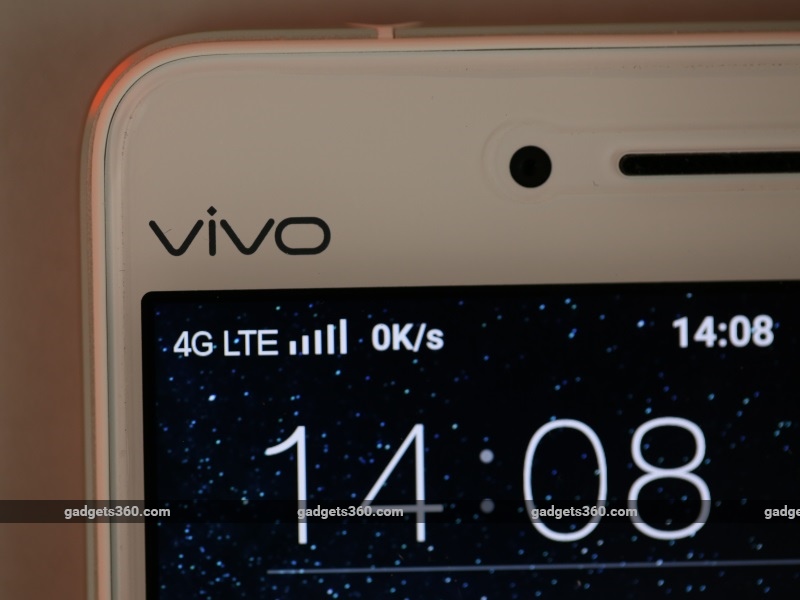 The
right side of the phone has
the power and volume buttons, while the left has the hybrid SIM tray.
The primary SIM slot accepts a Micro-SIM, while the secondary one
will take either a microSD card for storage expansion or a Nano-SIM for
dual-SIM connectivity. The top has the 3.5mm socket, while the
bottom has the Micro-USB port, microphone, and speaker.
The
right side of the phone has
the power and volume buttons, while the left has the hybrid SIM tray.
The primary SIM slot accepts a Micro-SIM, while the secondary one
will take either a microSD card for storage expansion or a Nano-SIM for
dual-SIM connectivity. The top has the 3.5mm socket, while the
bottom has the Micro-USB port, microphone, and speaker.
The back of the phone has the camera and flash, Vivo logo and fingerprint sensor, which works quickly and accurately to unlock the phone and let you access any files that you want to lock away privately. You can store up to five fingerprints for use with the sensor, and the phone can be directly unlocked from standby without first waking it.
The screen of the phone is a full-HD IPS LCD display, with a density of 401ppi. It's extremely sharp, and also fairly bright and easy to view even under bright sunlight. Black levels are acceptable for an IPS LCD screen, and colours are vibrant and accurate as well. The colour tone is completely neutral, which keeps the colours and general look of the screen standard and easy to view.
 Specifications and software
Specifications and software
The Vivo V3Max is powered by the new octa-core Qualcomm Snapdragon 652 SoC clocked at 1.8GHz for four of its cores and 1.4GHz for the other four. The Snapdragon 652 is one of the newest and most capable mid-range SoCs from Qualcomm, and comes with a promise of performance that is practically flagship-grade. There's also 4GB of RAM, which will certainly help in that department, along with 32GB of internal storage (expandable by up to 128GB).
There's also a 3000mAh battery, support for USB OTG with an adapter included in the box, Bluetooth 4.1 connectivity with A2DP, and 4G on both SIMs, with FDD Band 3 and TDD Band 40 both supported. Unfortunately, as previously stated, you will be forced to choose between a second SIM and expandable storage because of the use of a hybrid slot.
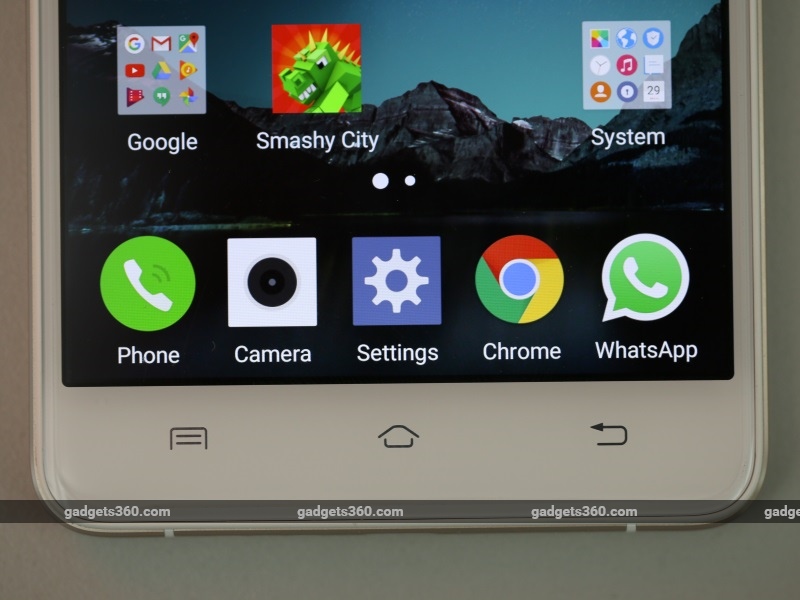 A
major
feature of the phone is the use of dual-engine charging, which uses two
controller chips and circuits to charge the battery faster. This does
translate to quicker charging times when you use a compatible charger,
and the bundled one does work very
quickly. Although other smartphones use technology such as Qualcomm's
Quick Charge to achieve similar results, this is a novel approach and
works equally effectively.
A
major
feature of the phone is the use of dual-engine charging, which uses two
controller chips and circuits to charge the battery faster. This does
translate to quicker charging times when you use a compatible charger,
and the bundled one does work very
quickly. Although other smartphones use technology such as Qualcomm's
Quick Charge to achieve similar results, this is a novel approach and
works equally effectively.
The V3Max runs Android 5.1, with Vivo's custom FunTouch OS 2.5 overlay on top. This is drastically different from what we're used to seeing on other Android smartphones, as FunTouch has been designed to look and feel like iOS. It's single-layered with no app drawer, and there's even a control panel which gives you access to key toggles and settings by swiping up from the bottom. The Settings app which is fairly different from what we're used to seeing on Android.
There is, of course, no denying that this is an Android smartphone, and it does feel as such most of the time despite the attempt to mimic iOS. Widgets are usable on the home screens in typical fashion, and not limited to the notifications shade as is the case with iOS. The Vivo V3Max will, however, take a bit of getting used to because of its different approach to Android, and lack of customisability and tweaks.
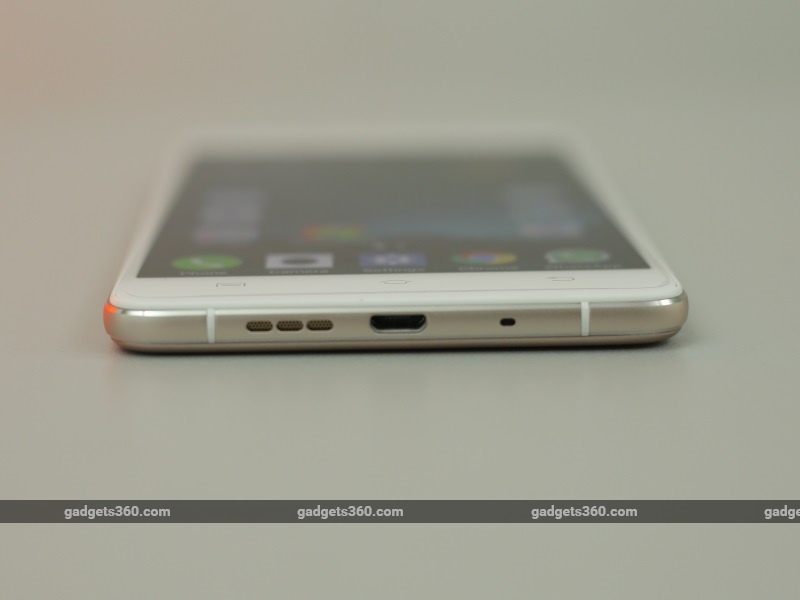 Camera
Camera
The Vivo V3Max has a 13-megapixel primary camera with single-tone LED flash, along with an 8-megapixel front camera. Both are capable of recording video at up to 1080p resolution, along with various photo and video modes including popular options such as panorama, slow motion, and HDR.
The camera app has, unsurprisingly given the rest of the software, been designed to look exactly like the one on iOS. That said, it isn't particularly bad, as the focus on simplicity and ease of use is refreshing. Most important controls are within easy reach, and there's no settings menu as such. Instead, controls for resolution, timer and capture methods are implemented in the form of toggles at the bottom of the mode switcher menu. There is also a full-fledged manual mode to give you a bit more control over your photography.
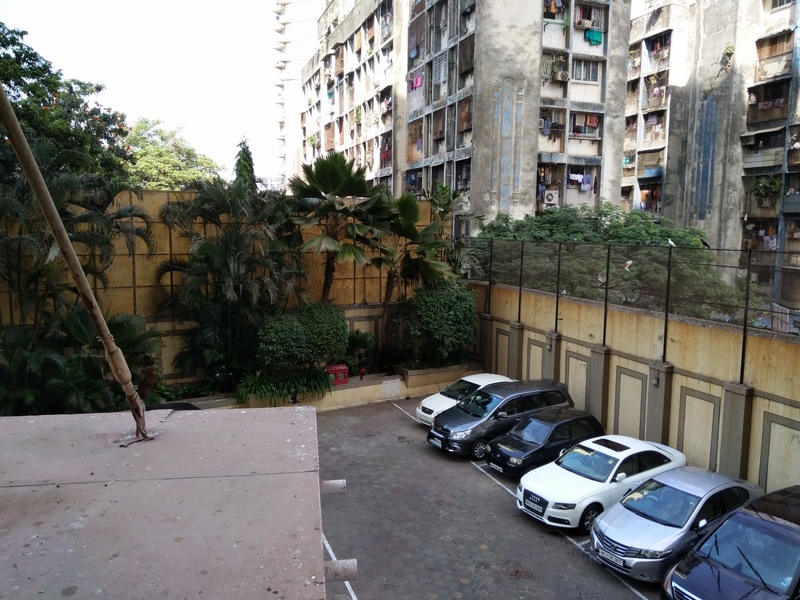 (Tap to see full size Vivo V3Max camera sample)Pictures taken with
the Vivo V3Max are fairly sharp and bright, but colours feel a bit dull
and unexciting. However, there is a tendency for the brightest
parts of pictures to get washed out, as the camera has a bit of trouble with adjusting
to light outside the focus area. The level of detail in pictures is
excellent, however, and images are surprisingly free of grain even on
zooming far in.
(Tap to see full size Vivo V3Max camera sample)Pictures taken with
the Vivo V3Max are fairly sharp and bright, but colours feel a bit dull
and unexciting. However, there is a tendency for the brightest
parts of pictures to get washed out, as the camera has a bit of trouble with adjusting
to light outside the focus area. The level of detail in pictures is
excellent, however, and images are surprisingly free of grain even on
zooming far in.
The camera does have some trouble capturing moving objects, which tend to blur more often than not. Additionally, images in low light tend to lose any vibrancy in colour, although sharpness and lack of grain remains. Videos are decent, capturing plenty of detail and maintaining a good sense of motion and fluidity. On the whole, images are sharp and acceptable in most conditions, but fall short of being excellent.
 (Tap to see full size Vivo V3Max camera sample)Performance
(Tap to see full size Vivo V3Max camera sample)Performance
Performance is the department where the Vivo V3Max triumphs, offering serious competition to most other phones in this price range. The phone works well with most heavy tasks, and gaming is a pleasure thanks to the smooth performance and lack of lag and stutter. This is also made possible by the generous amount of RAM, which lets leave multiple apps running without impacting performance. Although a significant 1.5GB of RAM is in use even immediately after boot, the total of 4GB ensures that you won't really fall short.
The benchmark scores for the V3Max are excellent as well, with 71,168 and 34,861 in AnTuTu and Quadrant respectively. The graphical benchmark tests produced strong scores too, with 33fps in the T-Rex test of GFXBench and 17,663 in 3DMark Ice Storm Unlimited. The graphical capabilities of the phone are no doubt helped along by the capable processor and the excellent Adreno 510 GPU under the hood. It's also interesting to note that mid-range phones such as this are now outperforming flagships from just a year ago on most counts, and you don't have to pay a lot of money for good performance.
 The phone ran for 11 hours, 36 minutes in our video loop test,
and in ordinary day-to-day use would easily power through a whole day,
sometimes even more. However, this entirely depends on your usage patterns, as
playing games or generally making heavy use of the screen will drain the
battery quickly. The dual-engine charging technology helps
juice the phone up again quickly, so heavy usage is usually not a huge cause for
concern.
The phone ran for 11 hours, 36 minutes in our video loop test,
and in ordinary day-to-day use would easily power through a whole day,
sometimes even more. However, this entirely depends on your usage patterns, as
playing games or generally making heavy use of the screen will drain the
battery quickly. The dual-engine charging technology helps
juice the phone up again quickly, so heavy usage is usually not a huge cause for
concern.
The phone does tend to heat up a fair bit especially when playing games and charging. Connectivity with 4G and Wi-Fi is excellent as well, and the phone manages to hold onto signals well.
Vivo has always touted its phones as 'hi-fi' and audio-centric, so we tested the V3Max for its audio capabilities. Audio output through the phone's single speaker is incredibly loud, but it does tend to sound narrow and flat with music. When using headphones, performance improves noticeably. Although the bundled earphones are alright, you're better off using decent afte-rmarket headphones. The sonic signature is incredibly clean, open and neutral, allowing for excellent imaging and letting the headphone's sonic characteristics take centre-stage. It's an excellent device if you intend to use it as your primary music source.
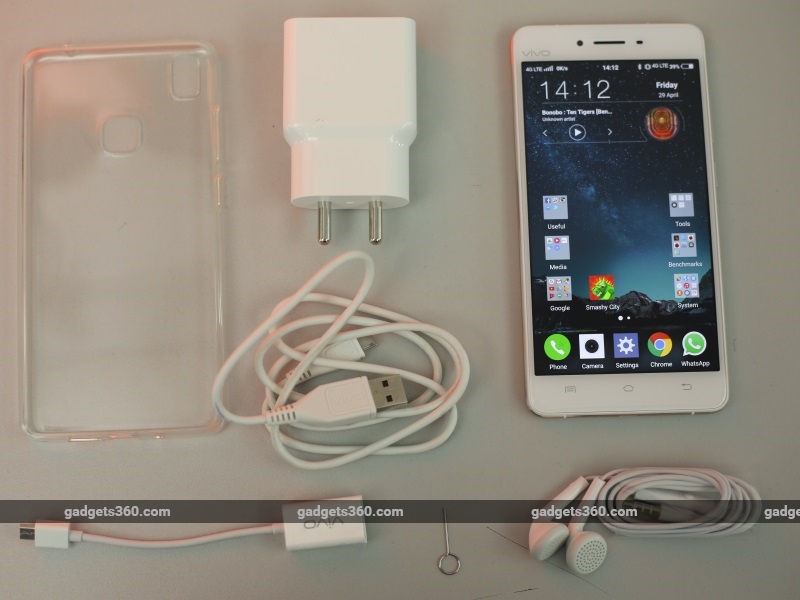 Verdict
Verdict
The Vivo V3Max is a perfectly capable mid-range smartphone that checks all boxes. It's built well, has a quick and accurate fingerprint sensor, a good screen and excellent performance. Battery life is good as well, and apart from photos lacking a bit of colour vibrancy, this phone is good in all ways. Our biggest complaint is its price: the Vivo V3Max costs far too much for what is being offered.
The V3Max compares best with the Xiaomi Redmi Note 3 (Review), a phone that costs half as much. And if you do want to spend up to Rs. 25,000 for your next smartphone, the Xiaomi Mi 5 (Review) is a much better overall package. Furthermore, there are plenty of phones that offer a similar overall experience at a lower price, such as the Lenovo Vibe X3 (Review), Google Nexus 5X (Review), and OnePlus 2 (Review). However, if you are looking for an Android phone that feels a bit like iOS, or want excellent audio and great overall performance with good build quality, the Vivo V3Max may well be worth considering
The Vivo V3Max isn't a small phone by any means. With a 5.5-inch screen and weighing in at a chunky 168g, this phone is a proper phablet and not for anyone who wants a phone that is easy to handle. Although it is fairly slim for the size, the V3Max definitely has a sense of bulkiness to it. The body is almost entirely metal, with a dull finish at the back and along the sides.
The front of the phone has a small Vivo logo in the top corner, a signature touch of the company that we rather like. Apart from this, there is also the front camera and proximity sensor at the top, and the capacitive Android keys at the bottom. These aren't backlit unfortunately, which makes it a bit hard to use the keys in the dark. At this price, backlit keys should really be a given.
 The
right side of the phone has
the power and volume buttons, while the left has the hybrid SIM tray.
The primary SIM slot accepts a Micro-SIM, while the secondary one
will take either a microSD card for storage expansion or a Nano-SIM for
dual-SIM connectivity. The top has the 3.5mm socket, while the
bottom has the Micro-USB port, microphone, and speaker.
The
right side of the phone has
the power and volume buttons, while the left has the hybrid SIM tray.
The primary SIM slot accepts a Micro-SIM, while the secondary one
will take either a microSD card for storage expansion or a Nano-SIM for
dual-SIM connectivity. The top has the 3.5mm socket, while the
bottom has the Micro-USB port, microphone, and speaker. The back of the phone has the camera and flash, Vivo logo and fingerprint sensor, which works quickly and accurately to unlock the phone and let you access any files that you want to lock away privately. You can store up to five fingerprints for use with the sensor, and the phone can be directly unlocked from standby without first waking it.
The screen of the phone is a full-HD IPS LCD display, with a density of 401ppi. It's extremely sharp, and also fairly bright and easy to view even under bright sunlight. Black levels are acceptable for an IPS LCD screen, and colours are vibrant and accurate as well. The colour tone is completely neutral, which keeps the colours and general look of the screen standard and easy to view.
 Specifications and software
Specifications and softwareThe Vivo V3Max is powered by the new octa-core Qualcomm Snapdragon 652 SoC clocked at 1.8GHz for four of its cores and 1.4GHz for the other four. The Snapdragon 652 is one of the newest and most capable mid-range SoCs from Qualcomm, and comes with a promise of performance that is practically flagship-grade. There's also 4GB of RAM, which will certainly help in that department, along with 32GB of internal storage (expandable by up to 128GB).
There's also a 3000mAh battery, support for USB OTG with an adapter included in the box, Bluetooth 4.1 connectivity with A2DP, and 4G on both SIMs, with FDD Band 3 and TDD Band 40 both supported. Unfortunately, as previously stated, you will be forced to choose between a second SIM and expandable storage because of the use of a hybrid slot.
 A
major
feature of the phone is the use of dual-engine charging, which uses two
controller chips and circuits to charge the battery faster. This does
translate to quicker charging times when you use a compatible charger,
and the bundled one does work very
quickly. Although other smartphones use technology such as Qualcomm's
Quick Charge to achieve similar results, this is a novel approach and
works equally effectively.
A
major
feature of the phone is the use of dual-engine charging, which uses two
controller chips and circuits to charge the battery faster. This does
translate to quicker charging times when you use a compatible charger,
and the bundled one does work very
quickly. Although other smartphones use technology such as Qualcomm's
Quick Charge to achieve similar results, this is a novel approach and
works equally effectively.The V3Max runs Android 5.1, with Vivo's custom FunTouch OS 2.5 overlay on top. This is drastically different from what we're used to seeing on other Android smartphones, as FunTouch has been designed to look and feel like iOS. It's single-layered with no app drawer, and there's even a control panel which gives you access to key toggles and settings by swiping up from the bottom. The Settings app which is fairly different from what we're used to seeing on Android.
There is, of course, no denying that this is an Android smartphone, and it does feel as such most of the time despite the attempt to mimic iOS. Widgets are usable on the home screens in typical fashion, and not limited to the notifications shade as is the case with iOS. The Vivo V3Max will, however, take a bit of getting used to because of its different approach to Android, and lack of customisability and tweaks.
 Camera
CameraThe Vivo V3Max has a 13-megapixel primary camera with single-tone LED flash, along with an 8-megapixel front camera. Both are capable of recording video at up to 1080p resolution, along with various photo and video modes including popular options such as panorama, slow motion, and HDR.
The camera app has, unsurprisingly given the rest of the software, been designed to look exactly like the one on iOS. That said, it isn't particularly bad, as the focus on simplicity and ease of use is refreshing. Most important controls are within easy reach, and there's no settings menu as such. Instead, controls for resolution, timer and capture methods are implemented in the form of toggles at the bottom of the mode switcher menu. There is also a full-fledged manual mode to give you a bit more control over your photography.
 (Tap to see full size Vivo V3Max camera sample)Pictures taken with
the Vivo V3Max are fairly sharp and bright, but colours feel a bit dull
and unexciting. However, there is a tendency for the brightest
parts of pictures to get washed out, as the camera has a bit of trouble with adjusting
to light outside the focus area. The level of detail in pictures is
excellent, however, and images are surprisingly free of grain even on
zooming far in.
(Tap to see full size Vivo V3Max camera sample)Pictures taken with
the Vivo V3Max are fairly sharp and bright, but colours feel a bit dull
and unexciting. However, there is a tendency for the brightest
parts of pictures to get washed out, as the camera has a bit of trouble with adjusting
to light outside the focus area. The level of detail in pictures is
excellent, however, and images are surprisingly free of grain even on
zooming far in.The camera does have some trouble capturing moving objects, which tend to blur more often than not. Additionally, images in low light tend to lose any vibrancy in colour, although sharpness and lack of grain remains. Videos are decent, capturing plenty of detail and maintaining a good sense of motion and fluidity. On the whole, images are sharp and acceptable in most conditions, but fall short of being excellent.
 (Tap to see full size Vivo V3Max camera sample)Performance
(Tap to see full size Vivo V3Max camera sample)PerformancePerformance is the department where the Vivo V3Max triumphs, offering serious competition to most other phones in this price range. The phone works well with most heavy tasks, and gaming is a pleasure thanks to the smooth performance and lack of lag and stutter. This is also made possible by the generous amount of RAM, which lets leave multiple apps running without impacting performance. Although a significant 1.5GB of RAM is in use even immediately after boot, the total of 4GB ensures that you won't really fall short.
The benchmark scores for the V3Max are excellent as well, with 71,168 and 34,861 in AnTuTu and Quadrant respectively. The graphical benchmark tests produced strong scores too, with 33fps in the T-Rex test of GFXBench and 17,663 in 3DMark Ice Storm Unlimited. The graphical capabilities of the phone are no doubt helped along by the capable processor and the excellent Adreno 510 GPU under the hood. It's also interesting to note that mid-range phones such as this are now outperforming flagships from just a year ago on most counts, and you don't have to pay a lot of money for good performance.
 The phone ran for 11 hours, 36 minutes in our video loop test,
and in ordinary day-to-day use would easily power through a whole day,
sometimes even more. However, this entirely depends on your usage patterns, as
playing games or generally making heavy use of the screen will drain the
battery quickly. The dual-engine charging technology helps
juice the phone up again quickly, so heavy usage is usually not a huge cause for
concern.
The phone ran for 11 hours, 36 minutes in our video loop test,
and in ordinary day-to-day use would easily power through a whole day,
sometimes even more. However, this entirely depends on your usage patterns, as
playing games or generally making heavy use of the screen will drain the
battery quickly. The dual-engine charging technology helps
juice the phone up again quickly, so heavy usage is usually not a huge cause for
concern. The phone does tend to heat up a fair bit especially when playing games and charging. Connectivity with 4G and Wi-Fi is excellent as well, and the phone manages to hold onto signals well.
Vivo has always touted its phones as 'hi-fi' and audio-centric, so we tested the V3Max for its audio capabilities. Audio output through the phone's single speaker is incredibly loud, but it does tend to sound narrow and flat with music. When using headphones, performance improves noticeably. Although the bundled earphones are alright, you're better off using decent afte-rmarket headphones. The sonic signature is incredibly clean, open and neutral, allowing for excellent imaging and letting the headphone's sonic characteristics take centre-stage. It's an excellent device if you intend to use it as your primary music source.
 Verdict
VerdictThe Vivo V3Max is a perfectly capable mid-range smartphone that checks all boxes. It's built well, has a quick and accurate fingerprint sensor, a good screen and excellent performance. Battery life is good as well, and apart from photos lacking a bit of colour vibrancy, this phone is good in all ways. Our biggest complaint is its price: the Vivo V3Max costs far too much for what is being offered.
The V3Max compares best with the Xiaomi Redmi Note 3 (Review), a phone that costs half as much. And if you do want to spend up to Rs. 25,000 for your next smartphone, the Xiaomi Mi 5 (Review) is a much better overall package. Furthermore, there are plenty of phones that offer a similar overall experience at a lower price, such as the Lenovo Vibe X3 (Review), Google Nexus 5X (Review), and OnePlus 2 (Review). However, if you are looking for an Android phone that feels a bit like iOS, or want excellent audio and great overall performance with good build quality, the Vivo V3Max may well be worth considering
Pay Rs. 10 and Watch Unlimited Movies With This App
If
you want to watch English movies on the Internet, there is a huge list
of content providers that you can log in to right now, with some being
free and ad-supported, and others being fully paid. Apps such as
Netflix, Hooq, and Hotstar are all well-made, easy to use, and have huge
libraries on offer.
If you want just regional content though, then you might prefer to
turn to a specialised provider - that's where Fast Filmz comes in. The
app currently has a small library of over 150 Tamil movies, with plans
to add Telugu films soon while growing the Tamil catalogue through 2016,
and adding more regional languages over time. The app itself has a
simple, easy to use interface that puts a lot of focus on the
"superstars" of cinema. It's a paid app, but the charges are quite low;
you don't have to commit to an entire month's subscription, and you're
paying a mere Re. 1 per day, with support for carrier billing.
Users can subscribe to a monthly plan of Rs. 30, or they can choose
to get a Rs. 10 for 10-days pack. There's no cap on the number of films
you can download or stream in this time, so you could stock up on all
your favourite films for just Rs. 10. The service is truly unlimited,
with no advertisements. Another feature that's really useful is that you
can pay for the subscription directly via your carrier - Fast Film has
tied up with Aircel, Vodafone, Airtel, and Idea, covering most of the
major providers.
The app itself is divided into six sections - Stars, Scenes, New
Arrivals, Showcase, Explore, and My Downloads. The Stars section is,
well, the star here, and showcases large posters with pictures of the
actors, listing their movies, along with a link to the Scenes section
which includes clips of the actors, and a 'crackers' rating, which is
actually used for a leaderboard - so you can give crackers to your
favourite actors to make them the top rated stars in Fast Filmz.
 The catch is that the library is still quite small - for example, in
the stars section, you've got famous stars such as Rajinikanth, Jayam
Ravi, Vijay, Trisha, and many more, but tap on Rajinikanth and you see
only seven movies right now. The most recent of these was Kuselan which released in 2008.
The catch is that the library is still quite small - for example, in
the stars section, you've got famous stars such as Rajinikanth, Jayam
Ravi, Vijay, Trisha, and many more, but tap on Rajinikanth and you see
only seven movies right now. The most recent of these was Kuselan which released in 2008.
On tapping on the film, you will see the synopsis, and you can then
choose the video quality for downloading or streaming, and the app also
shows you the size of the file, so you can decide depending on your data
connectivity. You can download the files to your device to watch when
offline, or if space is a problem, stream the movies when you're online.
Surprisingly, the audio and video quality on the mobile screen
remained pretty reasonable even on a 2G network - it took some time to
buffer an, but at the medium setting (176MB for a full movie) it was
able to play smoothly after the initial loading time, and the quality
was quite acceptable.
The ease of use and the ability to stream reasonable quality on even
poor connections makes the app appealing, but the library definitely
needs to improve. Fast Filmz says it's working on this right now, and
hopefully a future update will also add the option for subtitles in
different languages, so that people who don't speak Tamil (for example)
but want to watch well known movies from the region, can also use the
app.
LG K7 LTE Review
LG recently launched the K10 LTE and K7 LTE in India, from its new budget series that was first unveiled at CES 2016. After having reviewed the K10 LTE, it's now time to take a look at its smaller sibling.
The K7 LTE is a bit more affordable, but that does come at the cost of features and specifications. At Rs. 9,500, the phone goes up against the likes of the Lenovo Vibe K5 Plus (Review), Coolpad Note 3 (Review) and the base model of the Xiaomi Redmi Note 3 (Review). Let's see if the K7 LTE can makes its presence felt among those heavyweights.
Look and feel
The K7 LTE is designed with the same pebble-like finish as its older sibling and from the front (or sides for that matter), it's hard to tell the two apart. The curved edges of the display blend seamlessly with the rest of the body, lending the phone a very nice look. The back cover has a milder texture as compared to the K10 LTE but continues to offer good grip. There's a 5-megapixel camera in the front along with the proximity sensor. Strangely, LG has decided to ditch the ambient light sensor, which means you now have to do adjust screen brightness manually. Build quality is otherwise not bad for a plastic phone.
 The 5-inch in-cell touch display is one of the first letdowns of the
K7 LTE, as its resolution is a measly 480x854 pixels. This results in a
pixel density of just 195ppi, which makes the edges of text and images
appear jagged. Viewing angles are still pretty decent however and so is
sunlight legibility. The charging port and headphones socket are placed
at the bottom while the rest of the buttons are at the back. The latter
have a very spongy feel and can be triggered accidentally while
commuting.
The 5-inch in-cell touch display is one of the first letdowns of the
K7 LTE, as its resolution is a measly 480x854 pixels. This results in a
pixel density of just 195ppi, which makes the edges of text and images
appear jagged. Viewing angles are still pretty decent however and so is
sunlight legibility. The charging port and headphones socket are placed
at the bottom while the rest of the buttons are at the back. The latter
have a very spongy feel and can be triggered accidentally while
commuting.
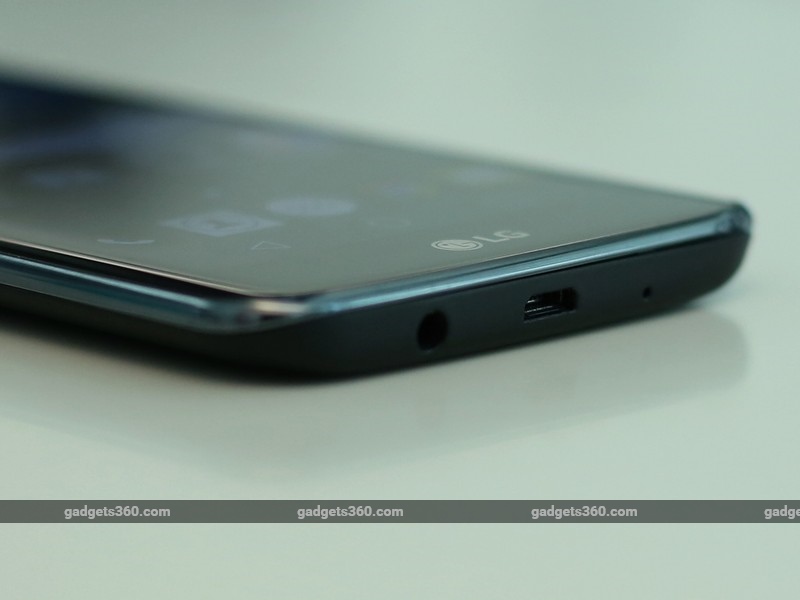 The K7 LTE ships with a charger, data cable, headset, and instruction
manuals. There's no flip cover like you get with the K10 LTE. The
quality of accessories is good and they feel durable, but the K7 LTE
itself doesn't feel as well-made as the K10 LTE. Then again, it is
priced lower. The low resolution display is a major compromise here - it
just isn't suitable for a screen of this physical size. There's also no
excuse for ditching the ambient light sensor, especially when the phone
is priced at nearly Rs. 10,000. Just like the its sibling, a
notification LED is also misssing.
The K7 LTE ships with a charger, data cable, headset, and instruction
manuals. There's no flip cover like you get with the K10 LTE. The
quality of accessories is good and they feel durable, but the K7 LTE
itself doesn't feel as well-made as the K10 LTE. Then again, it is
priced lower. The low resolution display is a major compromise here - it
just isn't suitable for a screen of this physical size. There's also no
excuse for ditching the ambient light sensor, especially when the phone
is priced at nearly Rs. 10,000. Just like the its sibling, a
notification LED is also misssing.
Software and specifications
Underneath the hood, the phone is powered by a rather ancient Qualcomm Snapdragon 210 quad-core SoC with 1.5GB of RAM, which is far from ideal. We managed 18,690 points in AnTuTu and about 14fps in GFXbench. To put things into perspective, the InFocus Bingo 10, a recently launched sub-Rs. 5,000 phone, scored 23,639 in AnTuTu and 11fps in GFXbench. Having said that, actual UI performance is not as bad as the benchmark numbers. Apart from intermittent lag, general performance is tolerable.
 Other specifications include 8GB of local storage, a dedicated
microSD card slot that can accommodate up to 32GB cards, Bluetooth 4.0,
Wi-Fi b/g/n, FM radio, and GPS. There's no NFC or USB OTG support. The
K7 LTE has slots for two Nano-SIM cards with 3G data on both SIMs. 4G
with VoLTE and VoWi-Fi support is present but only for the SIM in the
first slot. The phone also has a removable 2125mAh battery.
Other specifications include 8GB of local storage, a dedicated
microSD card slot that can accommodate up to 32GB cards, Bluetooth 4.0,
Wi-Fi b/g/n, FM radio, and GPS. There's no NFC or USB OTG support. The
K7 LTE has slots for two Nano-SIM cards with 3G data on both SIMs. 4G
with VoLTE and VoWi-Fi support is present but only for the SIM in the
first slot. The phone also has a removable 2125mAh battery.
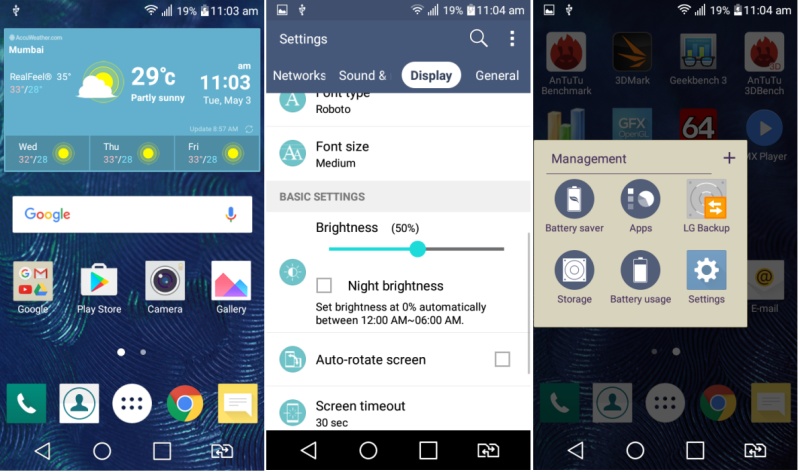 The software is virtually identical to what we saw on the K10 LTE. LG
ships a customised version of Android 5.1.1 Lollipop. There isn't much
bloatware, thankfully, except for some extras like LG Backup and
SmartWorld. The latter can be used to download themes, fonts, ringtones,
etc., to customise your phone. The toggle switches in the notifications
shade can be customised, along with the navigation bar at the bottom.
You can change lock screen effects as well as edit the quick-launch
shortcuts for apps you wish to have there.
The software is virtually identical to what we saw on the K10 LTE. LG
ships a customised version of Android 5.1.1 Lollipop. There isn't much
bloatware, thankfully, except for some extras like LG Backup and
SmartWorld. The latter can be used to download themes, fonts, ringtones,
etc., to customise your phone. The toggle switches in the notifications
shade can be customised, along with the navigation bar at the bottom.
You can change lock screen effects as well as edit the quick-launch
shortcuts for apps you wish to have there.
Performance
Despite the low-end SoC, the K7 LTE does a decent job of multitasking and running apps. There's a noticeable lag that creeps in every now and then but it's not so bad that it ruins the experience completely. Heavy apps, especially games, take a while to load and the performance isn't great. Pictures and text aren't as sharp as we would like them to be. The phone doesn't heat up too much with regular usage but it does get warm while gaming or charging. 4G works well and we didn't have any issues with call quality either.
 The phone handles full-HD video playback well, including some of our
high bit-rate files, but certain audio codecs like AC3 aren't supported.
The music player does support flac audio files and audio quality is
acceptable with the bundled headset. The rear speaker isn't great for
media playback but does its job for alerts. Out of the 8GB of local
storage, only 3.4GB is usable so you'll need a microSD card for your
media.
The phone handles full-HD video playback well, including some of our
high bit-rate files, but certain audio codecs like AC3 aren't supported.
The music player does support flac audio files and audio quality is
acceptable with the bundled headset. The rear speaker isn't great for
media playback but does its job for alerts. Out of the 8GB of local
storage, only 3.4GB is usable so you'll need a microSD card for your
media.


 (Tap to see full size LG K7 LTE camera samples)The
5-megapixel rear camera produces acceptable images in daylight. It
doesn't capture a lot of detail in landscapes, and colours turn out
slightly muted. We also managed to get some decently sharp images while
in motion. There's a bit of shutter lag which gets worse in low light.
Speaking of which, images taken in low light exhibit quite a bit of
noise which makes it tricky to get a usable shot. Close-ups are pretty
decent but once again, the sensor fails to produce good colours. Video
recording maxes out at 720p for the front and rear cameras. Quality is
okay but it can get really shaky if your hands aren't steady.
(Tap to see full size LG K7 LTE camera samples)The
5-megapixel rear camera produces acceptable images in daylight. It
doesn't capture a lot of detail in landscapes, and colours turn out
slightly muted. We also managed to get some decently sharp images while
in motion. There's a bit of shutter lag which gets worse in low light.
Speaking of which, images taken in low light exhibit quite a bit of
noise which makes it tricky to get a usable shot. Close-ups are pretty
decent but once again, the sensor fails to produce good colours. Video
recording maxes out at 720p for the front and rear cameras. Quality is
okay but it can get really shaky if your hands aren't steady.
The camera app is minimalistic, just like on the K10 LTE so you'll have to do without HDR, panorama, filters, and the like. The app does emulate a "flash" for selfies, essentially by lighting up the entire display to illuminate your face.
Battery life
The combination of a low-resolution display and low-powered SoC make the K7 LTE able to deliver good battery life, which is about the only real redeeming feature of this phone. In our video loop test, we managed to get 11 hours and 37 minutes of playback time, while regular usage gave us about a day's worth of battery life. Quick charge is not available.
 Verdict
Verdict
The LG K7 LTE feels out of place in today's cut-throat budget smartphone segment. The good battery life and design aside, it falls short on pretty much every count. Then there's the price - at Rs. 9,500, it's simply too expensive to even consider when you have phones like the Lenovo Vibe K5 Plus, Coolpad Note 3, and the Xiaomi Redmi Note 3, all of which perform better and are less expensive.
Just like the K10 LTE, LG needs to correct the price of the K7 LTE and match it with phones that share its feature-set. That would put it well under the Rs. 5,000 price level in India right now. If LG takes steps to correct this, the K7's compromises wouldn't seem so glaring, and that's the only shot it has at being relevant.

LG K7 LTE in pictures
Download the Gadgets 360 app for Android and iOS to stay up to date with the latest tech news, product
reviews, and exclusive deals on the popular mobiles.
The K7 LTE is a bit more affordable, but that does come at the cost of features and specifications. At Rs. 9,500, the phone goes up against the likes of the Lenovo Vibe K5 Plus (Review), Coolpad Note 3 (Review) and the base model of the Xiaomi Redmi Note 3 (Review). Let's see if the K7 LTE can makes its presence felt among those heavyweights.
Look and feel
The K7 LTE is designed with the same pebble-like finish as its older sibling and from the front (or sides for that matter), it's hard to tell the two apart. The curved edges of the display blend seamlessly with the rest of the body, lending the phone a very nice look. The back cover has a milder texture as compared to the K10 LTE but continues to offer good grip. There's a 5-megapixel camera in the front along with the proximity sensor. Strangely, LG has decided to ditch the ambient light sensor, which means you now have to do adjust screen brightness manually. Build quality is otherwise not bad for a plastic phone.
 The 5-inch in-cell touch display is one of the first letdowns of the
K7 LTE, as its resolution is a measly 480x854 pixels. This results in a
pixel density of just 195ppi, which makes the edges of text and images
appear jagged. Viewing angles are still pretty decent however and so is
sunlight legibility. The charging port and headphones socket are placed
at the bottom while the rest of the buttons are at the back. The latter
have a very spongy feel and can be triggered accidentally while
commuting.
The 5-inch in-cell touch display is one of the first letdowns of the
K7 LTE, as its resolution is a measly 480x854 pixels. This results in a
pixel density of just 195ppi, which makes the edges of text and images
appear jagged. Viewing angles are still pretty decent however and so is
sunlight legibility. The charging port and headphones socket are placed
at the bottom while the rest of the buttons are at the back. The latter
have a very spongy feel and can be triggered accidentally while
commuting.  The K7 LTE ships with a charger, data cable, headset, and instruction
manuals. There's no flip cover like you get with the K10 LTE. The
quality of accessories is good and they feel durable, but the K7 LTE
itself doesn't feel as well-made as the K10 LTE. Then again, it is
priced lower. The low resolution display is a major compromise here - it
just isn't suitable for a screen of this physical size. There's also no
excuse for ditching the ambient light sensor, especially when the phone
is priced at nearly Rs. 10,000. Just like the its sibling, a
notification LED is also misssing.
The K7 LTE ships with a charger, data cable, headset, and instruction
manuals. There's no flip cover like you get with the K10 LTE. The
quality of accessories is good and they feel durable, but the K7 LTE
itself doesn't feel as well-made as the K10 LTE. Then again, it is
priced lower. The low resolution display is a major compromise here - it
just isn't suitable for a screen of this physical size. There's also no
excuse for ditching the ambient light sensor, especially when the phone
is priced at nearly Rs. 10,000. Just like the its sibling, a
notification LED is also misssing.
Software and specifications
Underneath the hood, the phone is powered by a rather ancient Qualcomm Snapdragon 210 quad-core SoC with 1.5GB of RAM, which is far from ideal. We managed 18,690 points in AnTuTu and about 14fps in GFXbench. To put things into perspective, the InFocus Bingo 10, a recently launched sub-Rs. 5,000 phone, scored 23,639 in AnTuTu and 11fps in GFXbench. Having said that, actual UI performance is not as bad as the benchmark numbers. Apart from intermittent lag, general performance is tolerable.
 Other specifications include 8GB of local storage, a dedicated
microSD card slot that can accommodate up to 32GB cards, Bluetooth 4.0,
Wi-Fi b/g/n, FM radio, and GPS. There's no NFC or USB OTG support. The
K7 LTE has slots for two Nano-SIM cards with 3G data on both SIMs. 4G
with VoLTE and VoWi-Fi support is present but only for the SIM in the
first slot. The phone also has a removable 2125mAh battery.
Other specifications include 8GB of local storage, a dedicated
microSD card slot that can accommodate up to 32GB cards, Bluetooth 4.0,
Wi-Fi b/g/n, FM radio, and GPS. There's no NFC or USB OTG support. The
K7 LTE has slots for two Nano-SIM cards with 3G data on both SIMs. 4G
with VoLTE and VoWi-Fi support is present but only for the SIM in the
first slot. The phone also has a removable 2125mAh battery.  The software is virtually identical to what we saw on the K10 LTE. LG
ships a customised version of Android 5.1.1 Lollipop. There isn't much
bloatware, thankfully, except for some extras like LG Backup and
SmartWorld. The latter can be used to download themes, fonts, ringtones,
etc., to customise your phone. The toggle switches in the notifications
shade can be customised, along with the navigation bar at the bottom.
You can change lock screen effects as well as edit the quick-launch
shortcuts for apps you wish to have there.
The software is virtually identical to what we saw on the K10 LTE. LG
ships a customised version of Android 5.1.1 Lollipop. There isn't much
bloatware, thankfully, except for some extras like LG Backup and
SmartWorld. The latter can be used to download themes, fonts, ringtones,
etc., to customise your phone. The toggle switches in the notifications
shade can be customised, along with the navigation bar at the bottom.
You can change lock screen effects as well as edit the quick-launch
shortcuts for apps you wish to have there. Performance
Despite the low-end SoC, the K7 LTE does a decent job of multitasking and running apps. There's a noticeable lag that creeps in every now and then but it's not so bad that it ruins the experience completely. Heavy apps, especially games, take a while to load and the performance isn't great. Pictures and text aren't as sharp as we would like them to be. The phone doesn't heat up too much with regular usage but it does get warm while gaming or charging. 4G works well and we didn't have any issues with call quality either.
 The phone handles full-HD video playback well, including some of our
high bit-rate files, but certain audio codecs like AC3 aren't supported.
The music player does support flac audio files and audio quality is
acceptable with the bundled headset. The rear speaker isn't great for
media playback but does its job for alerts. Out of the 8GB of local
storage, only 3.4GB is usable so you'll need a microSD card for your
media.
The phone handles full-HD video playback well, including some of our
high bit-rate files, but certain audio codecs like AC3 aren't supported.
The music player does support flac audio files and audio quality is
acceptable with the bundled headset. The rear speaker isn't great for
media playback but does its job for alerts. Out of the 8GB of local
storage, only 3.4GB is usable so you'll need a microSD card for your
media. 

 (Tap to see full size LG K7 LTE camera samples)The
5-megapixel rear camera produces acceptable images in daylight. It
doesn't capture a lot of detail in landscapes, and colours turn out
slightly muted. We also managed to get some decently sharp images while
in motion. There's a bit of shutter lag which gets worse in low light.
Speaking of which, images taken in low light exhibit quite a bit of
noise which makes it tricky to get a usable shot. Close-ups are pretty
decent but once again, the sensor fails to produce good colours. Video
recording maxes out at 720p for the front and rear cameras. Quality is
okay but it can get really shaky if your hands aren't steady.
(Tap to see full size LG K7 LTE camera samples)The
5-megapixel rear camera produces acceptable images in daylight. It
doesn't capture a lot of detail in landscapes, and colours turn out
slightly muted. We also managed to get some decently sharp images while
in motion. There's a bit of shutter lag which gets worse in low light.
Speaking of which, images taken in low light exhibit quite a bit of
noise which makes it tricky to get a usable shot. Close-ups are pretty
decent but once again, the sensor fails to produce good colours. Video
recording maxes out at 720p for the front and rear cameras. Quality is
okay but it can get really shaky if your hands aren't steady.The camera app is minimalistic, just like on the K10 LTE so you'll have to do without HDR, panorama, filters, and the like. The app does emulate a "flash" for selfies, essentially by lighting up the entire display to illuminate your face.
Battery life
The combination of a low-resolution display and low-powered SoC make the K7 LTE able to deliver good battery life, which is about the only real redeeming feature of this phone. In our video loop test, we managed to get 11 hours and 37 minutes of playback time, while regular usage gave us about a day's worth of battery life. Quick charge is not available.
 Verdict
VerdictThe LG K7 LTE feels out of place in today's cut-throat budget smartphone segment. The good battery life and design aside, it falls short on pretty much every count. Then there's the price - at Rs. 9,500, it's simply too expensive to even consider when you have phones like the Lenovo Vibe K5 Plus, Coolpad Note 3, and the Xiaomi Redmi Note 3, all of which perform better and are less expensive.
Just like the K10 LTE, LG needs to correct the price of the K7 LTE and match it with phones that share its feature-set. That would put it well under the Rs. 5,000 price level in India right now. If LG takes steps to correct this, the K7's compromises wouldn't seem so glaring, and that's the only shot it has at being relevant.

LG K7 LTE in pictures
Creo Mark 1 Review
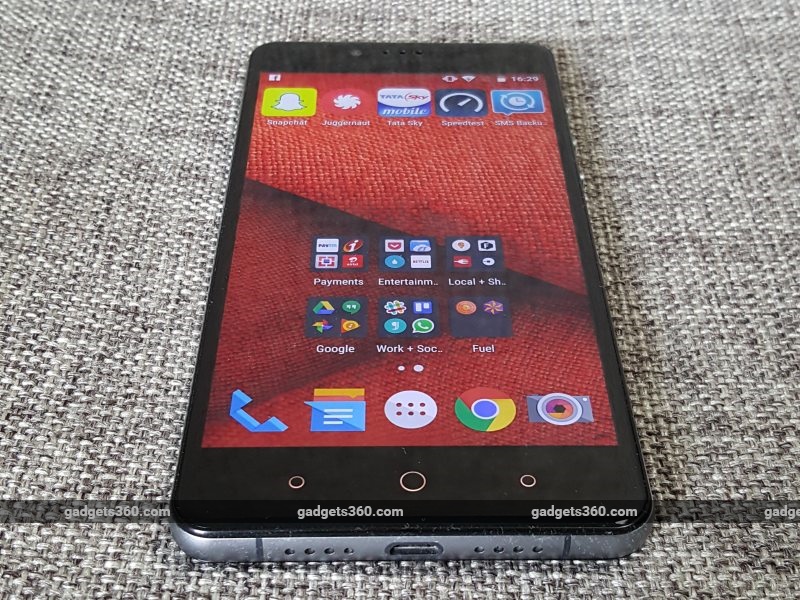
The
Creo Mark 1, designed in Bengaluru, promises to be a new phone every
month. When you think of it, that's a somewhat strange premise - the
idea of a phone that gets better over time is appealing, but we'd prefer
a really good phone today, please. We spent a lot of time with the Creo Mark 1, which launched on April 13
(including a month in its beta testing program) and in this time, we've
come away both impressed with the output of the very young company
behind it, but also wishing things were just a little bit better.
What's annoying about the Creo Mark 1 is how close it gets to being a really good phone. However, it falls just a little short at some crucial points, and that ends up being much more frustrating than a generally mediocre phone would have been.
The company behind the Mark 1 has previously made only two other products, the Chromecast-like Teewe dongle, and its successor, the Teewe 2. We thought both those products showed promise but fell short of the established competition (Google's Chromecast), and with the case of the Creo Mark 1, it feels the same.
Creo has decided to launch the Mark 1 at the "budget flagship" price of Rs. 20,000, and so it faces tough competition. Read on to see how it measures up.
Look and feel
The Creo Mark 1 looks a lot like the Sony Xperia Z3 - it has similar rounded edges on an otherwise brick-like shape, and features round chrome buttons on the right. Unlike the Xperia Z3, this phone lacks waterproofing and dustproofing, and it's also a fairly chunky phone for 2016.
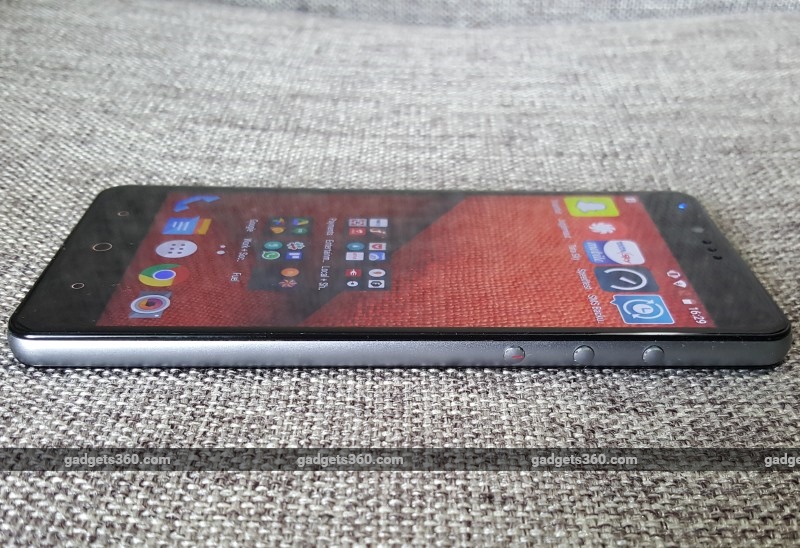 That's not necessarily a drawback - we've been complaining that as phones get thinner, they're less comfortable to hold
- but the 5.5-inch display is also pretty broad, with slightly thick
side borders. The Mark 1 is closer in size to a typical phablet, which
may or may not appeal to you.
That's not necessarily a drawback - we've been complaining that as phones get thinner, they're less comfortable to hold
- but the 5.5-inch display is also pretty broad, with slightly thick
side borders. The Mark 1 is closer in size to a typical phablet, which
may or may not appeal to you.
The design is otherwise pretty standard for a smartphone - the front is a glossy slab, with three capacitive buttons near the bottom. The functions of the buttons can be customised in the Settings app, which is why they don't have specific icons - all three are just plain circles. There's the front camera near the top, and circular power and volume buttons on the right. The left is plain, with two trays near the top - the first for a Nano-SIM or microSD card, and the second for a Micro-SIM. Lower down on the left, there's space where you can have up to 40 characters of text (such as your name or any message) engraved while buying the device.
The bottom has the Micro-USB charging port, while the 3.5mm audio socket is on top. You have the primary camera and flash in the top left corner of the rear, with a minimal and sleek Creo logo near the middle.
The result looks good - it isn't innovative or path-breaking, but it isn't in your face either, and has a sense of style. What's more, the phone feels well put-together. There are no sharp seams or edges, and no parts that don't feel fitted slickly. The glass front and back collect fingerprints and let the phone slide a little too much when you place it on a table, but they make the phone feel really good to hold, and help sell the idea that it's a premium device.
 This extends to the display as well - the 5.5-inch screen is bright
and colourful, without feeling oversaturated. It's a nice display to
watch videos on, particularly considering the QHD (1440x2560)
resolution. However, that doesn't come without downsides either, as
we'll get to in the performance section.
This extends to the display as well - the 5.5-inch screen is bright
and colourful, without feeling oversaturated. It's a nice display to
watch videos on, particularly considering the QHD (1440x2560)
resolution. However, that doesn't come without downsides either, as
we'll get to in the performance section.
Specifications and software
Creo's goal of giving you a new phone every month boils down to the promise of delivering monthly firmware updates which bring in features suggested by the community of users. It's a very good goal to hear about, considering how many phone makers seem to think that you should be happy with the software that comes out of the box and never expect any updates.
In terms of hardware, the Mark 1 packs a 1.95GHz octa-core MediaTek Helio X10 SoC, along with 3GB of RAM, and 32GB of storage that can be expanded by up to 128GB if you're willing to forego a second SIM.
The phone has a 21-megapixel rear camera and an 8-megapixel front camera. It's powered by a 3100mAh battery. All of this is pretty standard on paper these days - there's nothing very eye-catching about the spec-sheet other than the QHD display, but Creo's focus has been on software - a custom Android skin it calls Fuel OS.
Fuel OS looks and feels more or less like stock Android (it's running on top of Android 5.1.1) but it comes with a whole range of tweaks that are pretty interesting. For instance, the default SMS app shows your messages sorted into categories, separating ones sent by people and bulk messages sent by businesses (originating from addresses that start with VM/ DZ and so on). Business updates are further categorised as Important (for things such as delivery and bill updates) or Others. It's a small tweak, but a very welcome one that makes the SMS inbox far less cluttered and much more useful. There's a security feature that alerts you if a new SIM card is inserted into your Mark 1, allowing you to track it even if it isn't connected to the Internet, which sounds really helpful - at least for peace of mind.
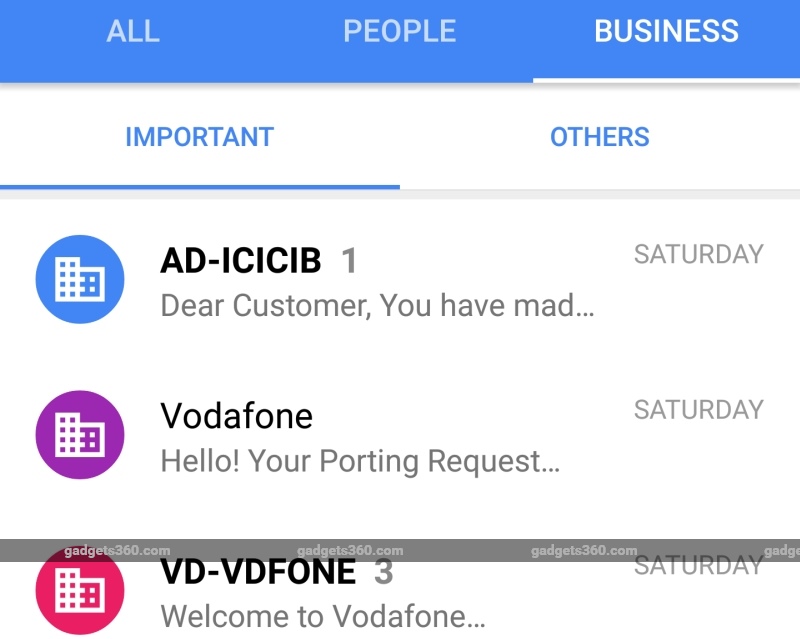 Then there's Sense, a full-fledged local search function that lets
you find anything in your phone, whether it's a setting buried deep
inside a menu, or a file you've downloaded and forgotten about. The last
major feature is Echo, a built in answering machine which stores
messages locally so it works even without an Internet connection.
Then there's Sense, a full-fledged local search function that lets
you find anything in your phone, whether it's a setting buried deep
inside a menu, or a file you've downloaded and forgotten about. The last
major feature is Echo, a built in answering machine which stores
messages locally so it works even without an Internet connection.
These are all tweaks that could be accomplished with third-party apps quite easily, but together they speak to Creo's overall vision of a phone which comes with all the bells and whistles you might want, saving you the trouble of looking for extras.
That doesn't mean that all of these features are perfect yet, though. For example, Echo is not a substitute for voicemail - it will only work when you're busy or otherwise miss a call, but it can't help if you're out of network coverage or if your battery has run down, which are more typical scenarios in which most of us might require an answering service. It doesn't help that answering machines never really caught on in India, and callers might be confused by your outgoing Echo message and just hang up.
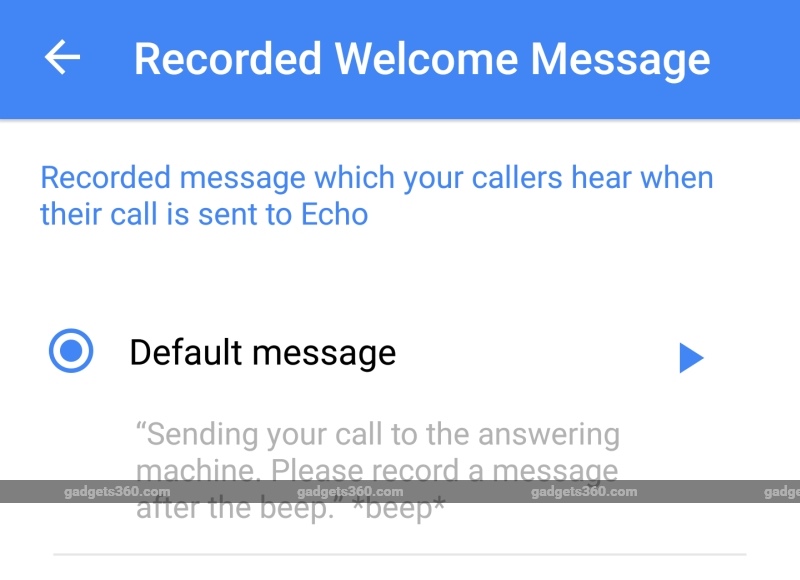 Similarly, while Sense is really great for quickly launching an app
or finding a contact or file, you type commands like "send a message to " or "set an alarm for
Similarly, while Sense is really great for quickly launching an app
or finding a contact or file, you type commands like "send a message to " or "set an alarm for
That's part of the unique nature of this phone - it's supposed to keep evolving, and the Creo team has made it very clear that there's a roadmap of updates and changes planned that should help address or at least alleviate the concerns we're raising. It's a great idea in theory, but if you're buying a phone, you're buying it for what it is right now, with everything that comes down the line being a bonus. With those expectations in mind, the software - while quite appealing and promising - suffers.
Camera
The camera is one area where the Creo Mark 1 is definitely better on paper than it is in real life. The front camera is fine, with no issues to speak of per se. However, the 21-megapixel rear camera is a little unreliable. In general, we found the camera to work much better outdoors in the daylight than in low-light conditions.
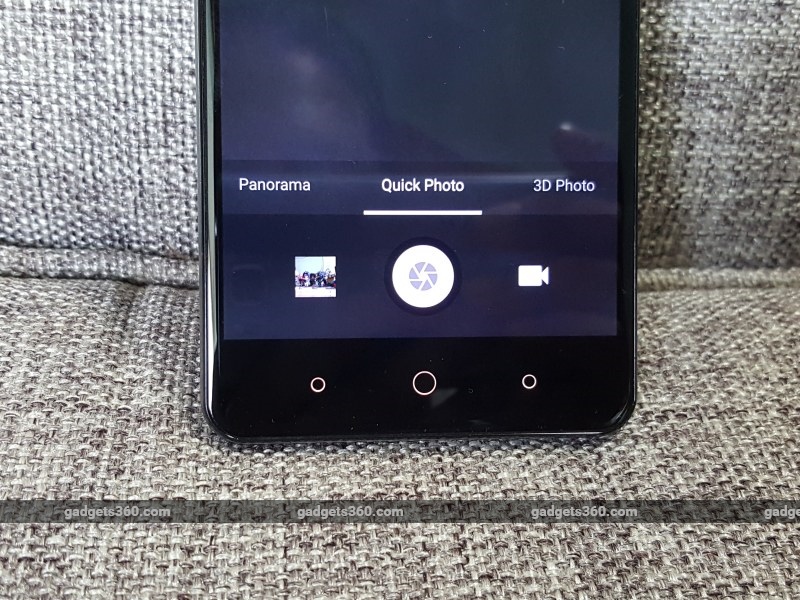 That being said, Creo's default camera app offers some really nice
tweaks. It has a number of modes such as 3D photos, slow-motion and
panorama. The camera locks focus and takes pictures quickly. Zoom in by
clicking on the image, and the picture appears grainy.
That being said, Creo's default camera app offers some really nice
tweaks. It has a number of modes such as 3D photos, slow-motion and
panorama. The camera locks focus and takes pictures quickly. Zoom in by
clicking on the image, and the picture appears grainy.
 Creo Mark 1 camera sample (tap to see full size)
In lower light, photos become even worse, which is less than ideal
considering that a lot of people do take photos indoors with friends.
The panorama mode and 3D photos are easy to take, but the results were
less appealing in both cases.
Creo Mark 1 camera sample (tap to see full size)
In lower light, photos become even worse, which is less than ideal
considering that a lot of people do take photos indoors with friends.
The panorama mode and 3D photos are easy to take, but the results were
less appealing in both cases.
 Creo Mark 1 camera sample (tap to see full size)
For many people, the camera makes or breaks smartphone, and for that reason, the Creo Mark 1 might not be the top choice.
Creo Mark 1 camera sample (tap to see full size)
For many people, the camera makes or breaks smartphone, and for that reason, the Creo Mark 1 might not be the top choice.
Performance
The phone has a good set of specifications on paper, but the Creo Mark 1 didn't set our benchmark charts on fire. For example, its AnTuTu benchmark score was 41,206; Quadrant gave us 9,034; and GFXBench T-Rex ran at just 11fps.
It's worth noting though that benchmarks rarely tell the full story. We used the phone for over a month, and never felt that lag was a problem with day-to-day usage. Typical phone usage isn't all that demanding - answering calls and writing emails are functions that really don't tax most modern devices, even budget phones. Gaming wasn't a problem and we tried a number of popular games that all ran perfectly well, and we did not have any problems with long load times.
The downside we faced was a number of random bugs - for instance, the phone froze entirely while ringing, twice during our month-long test period. We could not answer or reject the call, or turn the phone off - all we could do was let it ring and ring and ring, until the caller gave up, at which point the phone suddenly rebooted. There was also a strange bug with notifications - while they worked perfectly most of the time, they would sometimes stop coming through altogether when connected to Wi-Fi, and then suddenly come all in a rush once the connection switched to mobile data.
The battery lasted just under 6 hours in our standard video loop test, which isn't great either. The culprit is likely the QHD screen, which also really hurts the battery life on several flagship phones. The phone will usually kept us going till around 6PM on a typical workday, but doing anything taxing such as playing a lot of games or watching HD movies on Netflix made the battery level drop much more quickly. You'll want to keep the charger with you at all times and fit in a short charge at some point during the day if you want to go out at night.
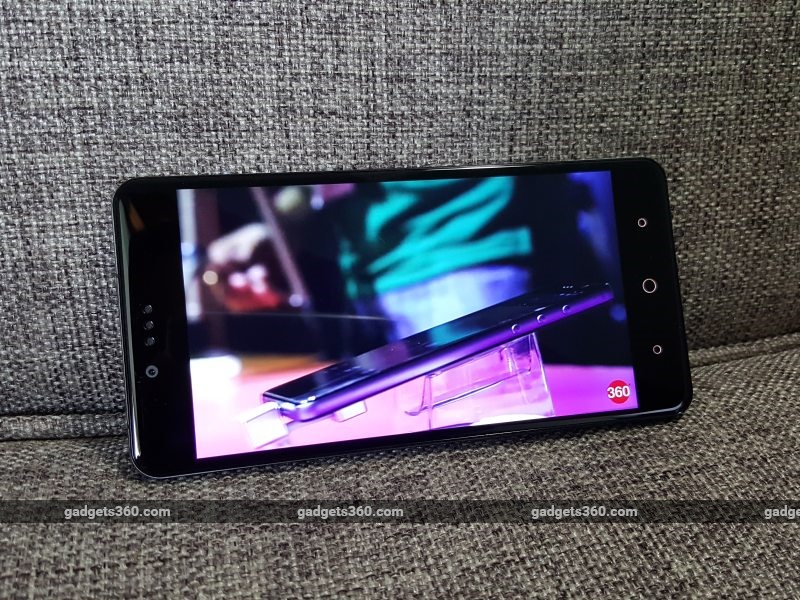 But there's a reason that Samsung and other companies continue to use
QHD, despite the downsides - it's pretty much a must for virtual
reality. Samsung's Gear VR headset
requires the screen to be of that resolution, and we've often used an
LG G3 for VR with a Cardboard headset for the same reason. Split across
two eyes, a 1080x1920-pixel display simply doesn't look good enough.
But there's a reason that Samsung and other companies continue to use
QHD, despite the downsides - it's pretty much a must for virtual
reality. Samsung's Gear VR headset
requires the screen to be of that resolution, and we've often used an
LG G3 for VR with a Cardboard headset for the same reason. Split across
two eyes, a 1080x1920-pixel display simply doesn't look good enough.
Unfortunately, the Creo Mark 1 cannot be used for VR for now. There seems to be some issue with its gyroscope, at least when used with a Google Cardboard headset. Up becomes down, left becomes right, and the sensor keeps drifting no matter what you do, meaning that it's impossible to use this phone. We didn't have this problem with some games, so it's not entirely clear what's going wrong. Whatever the case, the QHD screen serves only to look good, but it doesn't make a huge difference when you're watching movies or writing emails, and certainly impacts battery life.
The phone also heats up a lot while charging - there's a quick charger, and plugging it in for an hour means you're almost entirely topped up - but this isn't unusual and we've seen almost every other Android device with quick charging warm up quickly.
In terms of general performance, there's a lot to like about the Creo Mark 1, and despite the unimpressive numbers in benchmarks, we didn't really have any issues with it when running apps or in day to day usage.
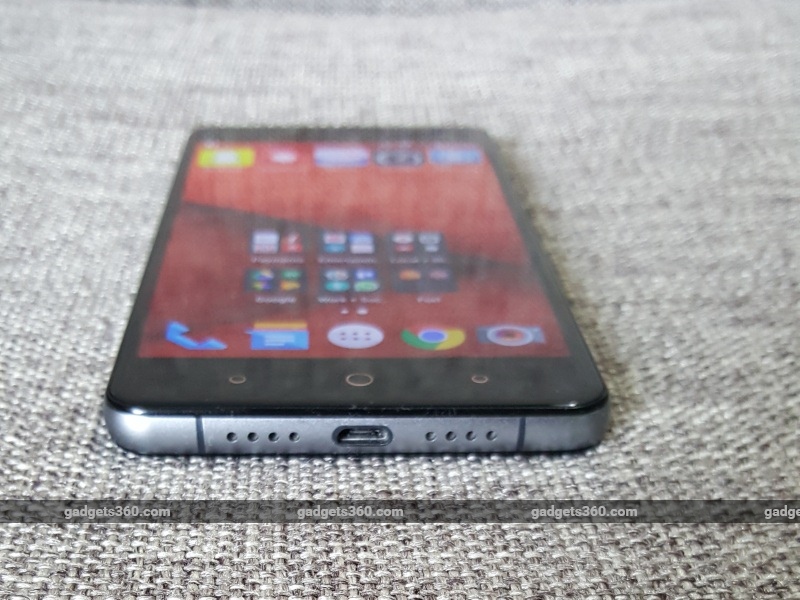 Verdict
Verdict
The Creo Mark 1 is a phone that's easy to like - it looks physically appealing and the software customisations are thoughtful without detracting from the core Android experience. However, the big selling point of this phone is not hardware, but rather software - and that's where a little more polish is still needed. The Mark 1 has potential, and that makes it all the more frustrating when you come across bugs and issues such as the random freezing or the VR-related problems
The Creo team has a plan in mind for making the phone a lot better as time passes, but as of date it's too soon to say whether that vision will work out or not. That said, the team is promising monthly updates and it has already rolled out improvements to features like the camera and battery life through the course of our test period, so it's clear that Creo is taking its vision seriously for now.
Should you buy this phone? Not if you care for the best specs and best benchmarks. On the other hand, if you're looking for a mostly hassle-free phone that comes with some cool bells and whistles now and the promise of more to come down the line, then the Creo Mark 1 might prove to be quite interesting.
Download the Gadgets 360 app for Android and iOS to stay up to date with the latest tech news, product
reviews, and exclusive deals on the popular mobiles.
What's annoying about the Creo Mark 1 is how close it gets to being a really good phone. However, it falls just a little short at some crucial points, and that ends up being much more frustrating than a generally mediocre phone would have been.
The company behind the Mark 1 has previously made only two other products, the Chromecast-like Teewe dongle, and its successor, the Teewe 2. We thought both those products showed promise but fell short of the established competition (Google's Chromecast), and with the case of the Creo Mark 1, it feels the same.
Creo has decided to launch the Mark 1 at the "budget flagship" price of Rs. 20,000, and so it faces tough competition. Read on to see how it measures up.
Look and feel
The Creo Mark 1 looks a lot like the Sony Xperia Z3 - it has similar rounded edges on an otherwise brick-like shape, and features round chrome buttons on the right. Unlike the Xperia Z3, this phone lacks waterproofing and dustproofing, and it's also a fairly chunky phone for 2016.
 That's not necessarily a drawback - we've been complaining that as phones get thinner, they're less comfortable to hold
- but the 5.5-inch display is also pretty broad, with slightly thick
side borders. The Mark 1 is closer in size to a typical phablet, which
may or may not appeal to you.
That's not necessarily a drawback - we've been complaining that as phones get thinner, they're less comfortable to hold
- but the 5.5-inch display is also pretty broad, with slightly thick
side borders. The Mark 1 is closer in size to a typical phablet, which
may or may not appeal to you.The design is otherwise pretty standard for a smartphone - the front is a glossy slab, with three capacitive buttons near the bottom. The functions of the buttons can be customised in the Settings app, which is why they don't have specific icons - all three are just plain circles. There's the front camera near the top, and circular power and volume buttons on the right. The left is plain, with two trays near the top - the first for a Nano-SIM or microSD card, and the second for a Micro-SIM. Lower down on the left, there's space where you can have up to 40 characters of text (such as your name or any message) engraved while buying the device.
The bottom has the Micro-USB charging port, while the 3.5mm audio socket is on top. You have the primary camera and flash in the top left corner of the rear, with a minimal and sleek Creo logo near the middle.
The result looks good - it isn't innovative or path-breaking, but it isn't in your face either, and has a sense of style. What's more, the phone feels well put-together. There are no sharp seams or edges, and no parts that don't feel fitted slickly. The glass front and back collect fingerprints and let the phone slide a little too much when you place it on a table, but they make the phone feel really good to hold, and help sell the idea that it's a premium device.
 This extends to the display as well - the 5.5-inch screen is bright
and colourful, without feeling oversaturated. It's a nice display to
watch videos on, particularly considering the QHD (1440x2560)
resolution. However, that doesn't come without downsides either, as
we'll get to in the performance section.
This extends to the display as well - the 5.5-inch screen is bright
and colourful, without feeling oversaturated. It's a nice display to
watch videos on, particularly considering the QHD (1440x2560)
resolution. However, that doesn't come without downsides either, as
we'll get to in the performance section.Specifications and software
Creo's goal of giving you a new phone every month boils down to the promise of delivering monthly firmware updates which bring in features suggested by the community of users. It's a very good goal to hear about, considering how many phone makers seem to think that you should be happy with the software that comes out of the box and never expect any updates.
In terms of hardware, the Mark 1 packs a 1.95GHz octa-core MediaTek Helio X10 SoC, along with 3GB of RAM, and 32GB of storage that can be expanded by up to 128GB if you're willing to forego a second SIM.
The phone has a 21-megapixel rear camera and an 8-megapixel front camera. It's powered by a 3100mAh battery. All of this is pretty standard on paper these days - there's nothing very eye-catching about the spec-sheet other than the QHD display, but Creo's focus has been on software - a custom Android skin it calls Fuel OS.
Fuel OS looks and feels more or less like stock Android (it's running on top of Android 5.1.1) but it comes with a whole range of tweaks that are pretty interesting. For instance, the default SMS app shows your messages sorted into categories, separating ones sent by people and bulk messages sent by businesses (originating from addresses that start with VM/ DZ and so on). Business updates are further categorised as Important (for things such as delivery and bill updates) or Others. It's a small tweak, but a very welcome one that makes the SMS inbox far less cluttered and much more useful. There's a security feature that alerts you if a new SIM card is inserted into your Mark 1, allowing you to track it even if it isn't connected to the Internet, which sounds really helpful - at least for peace of mind.
 Then there's Sense, a full-fledged local search function that lets
you find anything in your phone, whether it's a setting buried deep
inside a menu, or a file you've downloaded and forgotten about. The last
major feature is Echo, a built in answering machine which stores
messages locally so it works even without an Internet connection.
Then there's Sense, a full-fledged local search function that lets
you find anything in your phone, whether it's a setting buried deep
inside a menu, or a file you've downloaded and forgotten about. The last
major feature is Echo, a built in answering machine which stores
messages locally so it works even without an Internet connection.These are all tweaks that could be accomplished with third-party apps quite easily, but together they speak to Creo's overall vision of a phone which comes with all the bells and whistles you might want, saving you the trouble of looking for extras.
That doesn't mean that all of these features are perfect yet, though. For example, Echo is not a substitute for voicemail - it will only work when you're busy or otherwise miss a call, but it can't help if you're out of network coverage or if your battery has run down, which are more typical scenarios in which most of us might require an answering service. It doesn't help that answering machines never really caught on in India, and callers might be confused by your outgoing Echo message and just hang up.
 Similarly, while Sense is really great for quickly launching an app
or finding a contact or file, you type commands like "send a message to " or "set an alarm for
Similarly, while Sense is really great for quickly launching an app
or finding a contact or file, you type commands like "send a message to " or "set an alarm for That's part of the unique nature of this phone - it's supposed to keep evolving, and the Creo team has made it very clear that there's a roadmap of updates and changes planned that should help address or at least alleviate the concerns we're raising. It's a great idea in theory, but if you're buying a phone, you're buying it for what it is right now, with everything that comes down the line being a bonus. With those expectations in mind, the software - while quite appealing and promising - suffers.
Camera
The camera is one area where the Creo Mark 1 is definitely better on paper than it is in real life. The front camera is fine, with no issues to speak of per se. However, the 21-megapixel rear camera is a little unreliable. In general, we found the camera to work much better outdoors in the daylight than in low-light conditions.
 That being said, Creo's default camera app offers some really nice
tweaks. It has a number of modes such as 3D photos, slow-motion and
panorama. The camera locks focus and takes pictures quickly. Zoom in by
clicking on the image, and the picture appears grainy.
That being said, Creo's default camera app offers some really nice
tweaks. It has a number of modes such as 3D photos, slow-motion and
panorama. The camera locks focus and takes pictures quickly. Zoom in by
clicking on the image, and the picture appears grainy. Creo Mark 1 camera sample (tap to see full size)
In lower light, photos become even worse, which is less than ideal
considering that a lot of people do take photos indoors with friends.
The panorama mode and 3D photos are easy to take, but the results were
less appealing in both cases.
Creo Mark 1 camera sample (tap to see full size)
In lower light, photos become even worse, which is less than ideal
considering that a lot of people do take photos indoors with friends.
The panorama mode and 3D photos are easy to take, but the results were
less appealing in both cases. Creo Mark 1 camera sample (tap to see full size)
For many people, the camera makes or breaks smartphone, and for that reason, the Creo Mark 1 might not be the top choice.
Creo Mark 1 camera sample (tap to see full size)
For many people, the camera makes or breaks smartphone, and for that reason, the Creo Mark 1 might not be the top choice.Performance
The phone has a good set of specifications on paper, but the Creo Mark 1 didn't set our benchmark charts on fire. For example, its AnTuTu benchmark score was 41,206; Quadrant gave us 9,034; and GFXBench T-Rex ran at just 11fps.
It's worth noting though that benchmarks rarely tell the full story. We used the phone for over a month, and never felt that lag was a problem with day-to-day usage. Typical phone usage isn't all that demanding - answering calls and writing emails are functions that really don't tax most modern devices, even budget phones. Gaming wasn't a problem and we tried a number of popular games that all ran perfectly well, and we did not have any problems with long load times.
The downside we faced was a number of random bugs - for instance, the phone froze entirely while ringing, twice during our month-long test period. We could not answer or reject the call, or turn the phone off - all we could do was let it ring and ring and ring, until the caller gave up, at which point the phone suddenly rebooted. There was also a strange bug with notifications - while they worked perfectly most of the time, they would sometimes stop coming through altogether when connected to Wi-Fi, and then suddenly come all in a rush once the connection switched to mobile data.
The battery lasted just under 6 hours in our standard video loop test, which isn't great either. The culprit is likely the QHD screen, which also really hurts the battery life on several flagship phones. The phone will usually kept us going till around 6PM on a typical workday, but doing anything taxing such as playing a lot of games or watching HD movies on Netflix made the battery level drop much more quickly. You'll want to keep the charger with you at all times and fit in a short charge at some point during the day if you want to go out at night.
 But there's a reason that Samsung and other companies continue to use
QHD, despite the downsides - it's pretty much a must for virtual
reality. Samsung's Gear VR headset
requires the screen to be of that resolution, and we've often used an
LG G3 for VR with a Cardboard headset for the same reason. Split across
two eyes, a 1080x1920-pixel display simply doesn't look good enough.
But there's a reason that Samsung and other companies continue to use
QHD, despite the downsides - it's pretty much a must for virtual
reality. Samsung's Gear VR headset
requires the screen to be of that resolution, and we've often used an
LG G3 for VR with a Cardboard headset for the same reason. Split across
two eyes, a 1080x1920-pixel display simply doesn't look good enough.Unfortunately, the Creo Mark 1 cannot be used for VR for now. There seems to be some issue with its gyroscope, at least when used with a Google Cardboard headset. Up becomes down, left becomes right, and the sensor keeps drifting no matter what you do, meaning that it's impossible to use this phone. We didn't have this problem with some games, so it's not entirely clear what's going wrong. Whatever the case, the QHD screen serves only to look good, but it doesn't make a huge difference when you're watching movies or writing emails, and certainly impacts battery life.
The phone also heats up a lot while charging - there's a quick charger, and plugging it in for an hour means you're almost entirely topped up - but this isn't unusual and we've seen almost every other Android device with quick charging warm up quickly.
In terms of general performance, there's a lot to like about the Creo Mark 1, and despite the unimpressive numbers in benchmarks, we didn't really have any issues with it when running apps or in day to day usage.
 Verdict
VerdictThe Creo Mark 1 is a phone that's easy to like - it looks physically appealing and the software customisations are thoughtful without detracting from the core Android experience. However, the big selling point of this phone is not hardware, but rather software - and that's where a little more polish is still needed. The Mark 1 has potential, and that makes it all the more frustrating when you come across bugs and issues such as the random freezing or the VR-related problems
The Creo team has a plan in mind for making the phone a lot better as time passes, but as of date it's too soon to say whether that vision will work out or not. That said, the team is promising monthly updates and it has already rolled out improvements to features like the camera and battery life through the course of our test period, so it's clear that Creo is taking its vision seriously for now.
Should you buy this phone? Not if you care for the best specs and best benchmarks. On the other hand, if you're looking for a mostly hassle-free phone that comes with some cool bells and whistles now and the promise of more to come down the line, then the Creo Mark 1 might prove to be quite interesting.
Smarteefi Wi-Fi Smart Power Strip Review
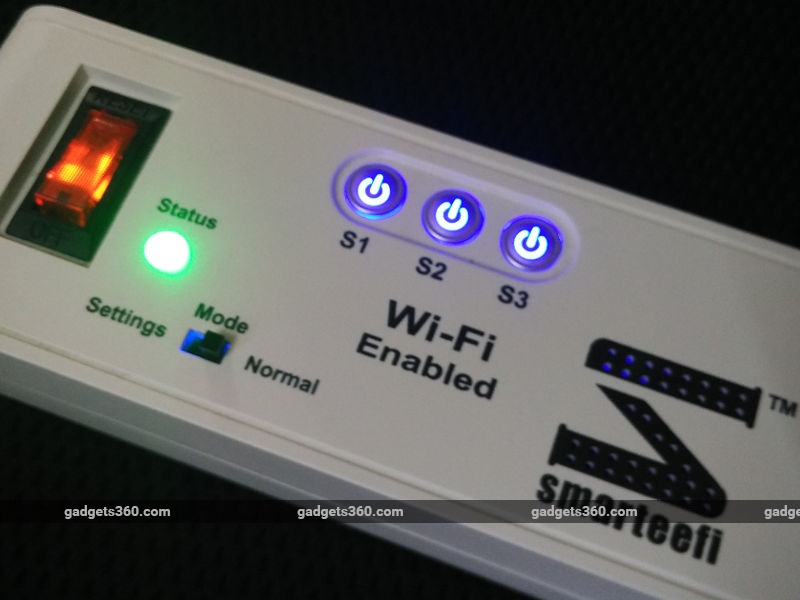
At
first glance, the Smarteefi SE315A Power Strip looks like any other
spike buster, which is an under-appreciated but essential part of every
PC user's life. The average techie probably needs one in every room to
have enough outlets for a smartphone, laptop, PC, router, etc. The
Smarteefi, manufactured by Delhi-based startup CoreEmbedded
Technologies, is an entry-level home automation solution which lets
users remotely toggle power to three plug points, while implementing
conventional surge protection features.
A Wi-Fi router and a live Internet connection are necessary for the device, which lets users control appliances plugged in to it through an Android app or a Web dashboard on the Smarteefi website. It should take about ten minutes to set up the power strip. The manual details step-by-step instructions concisely, and practically anyone with basic tech knowledge should be able set this up.
In a gist, you need to activate a setup mode on the power strip after turning it on, following which it shows up as a Wi-Fi access point. You then log in into the device through a Web browser (using the default IP 192.168.4.1), and enter the Wi-Fi name (SSID) and password of your existing Wi-Fi network. Hit save and toggle back to normal mode, after which the Smarteefi SE315A should be connected to your router, making it accessible from your other computing devices and anywhere else through the Internet.
Once the LED indicator shows a stable green, each plug on the power strip can be controlled remotely. We managed to nail the setup process on the first try and don't see any reason why you shouldn't be able to do so too. Once configured, it takes less than a second to turn a device off or on through the app, or Web interface.
The Smarteefi SE315A is 13 inches long; size of a standard power strip but about 10 percent thicker and with one less socket than a regular spike buster. The unit has slots on the back to enable wall mounting. It consumes 0.45W of power in standby, which is up to four times the power consumption of a typical smartphone in sleep mode.
The company says that it takes security seriously. Communication from the Smarteefi SE315A to and from its cloud service is encrypted using 128-bit AES, and communication between the cloud and the app is encrypted using SSL.
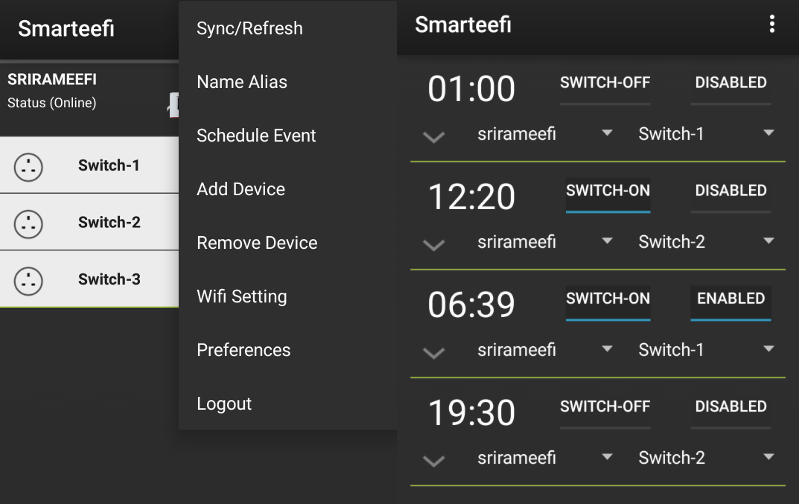 Configuring the app takes a few minutes, starting with registration,
following which users can add their Smarteefi power strip by entering
its serial number and activation code, which are printed on the bottom
of the unit.
Configuring the app takes a few minutes, starting with registration,
following which users can add their Smarteefi power strip by entering
its serial number and activation code, which are printed on the bottom
of the unit.
LED indicators on the power strip show which mode it is in - if it's blue, the power strip is in setup mode; if it's blinking green, the power strip is too far away from the router or there's a password issue. Red denotes that the strip has trouble connecting to the cloud. The board also has physical switches for each of the power outlets, which emit a blue LED light when turned on.
The Smarteefi Android app is minimal but effective. It offers no bells and whistles apart from scheduling, which can be used to turn power to any of the three universal outlets on or off on a daily or weekly schedule. Scheduled events on the app aren't synced with the cloud, which means that your Android device needs to be online with the app running in the background at the scheduled time, in order to send commands. On the other hand, you do get notifications when scheduled events are carried out successfully or if they fail. The app doesn't have features like IFTTT integration, though the company is working on a way to send push notifications to your phone when the physical switches on the power strip are used.
You can also control your Smarteefi power strip through any device that supports a Web browser, through this interface lacks the ability to create schedules. There's no app for iOS devices yet, but it's on the company's to-do list, with a planned launch date of June 2016.
CoreEmbedded Technologies has decided to go with only three sockets, which seems like a limitation at this point - a four- or six-socket model would have been more appealing. The company says that it wanted the product to look and feel just like a standard power strip, which dictated its final dimensions. Vipin Galhaut, CEO of the firm, told Gadgets 360 that he has received orders from industries for similar power strips with eight sockets, and he sees no reason to turn customers away. Versions with more sockets are in the pipeline, but the next product is going to be a controller that can fit behind an existing switchboard, he said.
Three plug points are still enough to automate simple activities - plug in a coffee maker, toaster oven and kettle, and you can have a full breakfast ready for you as you wake up. The Smarteefi SE315A can support a total power draw of up to 5 Amperes before its over-current safety protection is triggered, so you could plug multiple small devices into each socket if you want them all on or off at the same time.
 Users can have any number of these connected power strips in their
homes, all controlled individually through the same interface. If you
have an inverter at home, the Smarteefi SE315A can help you reduce load
by turning off devices that you don't need to run on batteries. The
ability to turn off a TV, PC or game console remotely could be of use to
parents (though any kid should be able to find a simple workaround -
just flip the switch to setup mode, and the device is cut off from your
router, disabling remote access).
Users can have any number of these connected power strips in their
homes, all controlled individually through the same interface. If you
have an inverter at home, the Smarteefi SE315A can help you reduce load
by turning off devices that you don't need to run on batteries. The
ability to turn off a TV, PC or game console remotely could be of use to
parents (though any kid should be able to find a simple workaround -
just flip the switch to setup mode, and the device is cut off from your
router, disabling remote access).
The Smarteefi SE315A can't be operated without an Internet connection, since all commands are routed through the cloud. Any ISP downtime or power failure will interrupt your ability to use it, which could be dangerous in cases where you need to turn something off at a particular time. Its lifecycle is also dependent on the company that manufactures it. For example, Revolv, a US-based IoT player which was acquired by Google, will stop supporting its devices, rendering them inoperable after May 15, 2016. Galhaut told Gadgets 360 that his three-year-old company is in this space for the long haul, with more devices in the pipeline. Its cloud service has an uptime of 99.9 percent, barring scheduled upgrades for major releases, he said.
The Smarteefi's SE315A's use cases are limited when compared to the Inoho's 5.1 home controller, priced at Rs. 11,999, which sits behind a switchboard and can be used to control electrical fittings and regulate fan speed as well. That's the space the company is looking to set target next. For now the Smarteefi SE315A complements such a solution by Internet-enabling appliances that need a plug point.
The Smart EEFI SE315A Power Strip is affordable, though much more expensive than ordinary power strips. It's intriguing for anyone looking to add some basic task automation to their day, and is something that every broadband-using geek would love. It could also be useful for the elderly and anyone with impaired mobility. Add a couple of multi-plug adapters, and its three sockets won't feel so limiting. However, it should be used only for convenience, not for any appliance or product that could be dangerous if you suddenly lose the ability to turn it on or off when you need to.
Price: Rs. 2,499
Pros
-Entry-level home automation at an affordable price
-Easy to set up and use
Cons:
-No app for iOS
-Scheduling only works through the Android app for now
-No IFTTT integration
-Requires an Internet connection at all times
Ratings (Out of 5)
Design: 3.0
Performance: 3.0
Value for money: 4.0
Overall: 3.0
A Wi-Fi router and a live Internet connection are necessary for the device, which lets users control appliances plugged in to it through an Android app or a Web dashboard on the Smarteefi website. It should take about ten minutes to set up the power strip. The manual details step-by-step instructions concisely, and practically anyone with basic tech knowledge should be able set this up.
In a gist, you need to activate a setup mode on the power strip after turning it on, following which it shows up as a Wi-Fi access point. You then log in into the device through a Web browser (using the default IP 192.168.4.1), and enter the Wi-Fi name (SSID) and password of your existing Wi-Fi network. Hit save and toggle back to normal mode, after which the Smarteefi SE315A should be connected to your router, making it accessible from your other computing devices and anywhere else through the Internet.
Once the LED indicator shows a stable green, each plug on the power strip can be controlled remotely. We managed to nail the setup process on the first try and don't see any reason why you shouldn't be able to do so too. Once configured, it takes less than a second to turn a device off or on through the app, or Web interface.
The Smarteefi SE315A is 13 inches long; size of a standard power strip but about 10 percent thicker and with one less socket than a regular spike buster. The unit has slots on the back to enable wall mounting. It consumes 0.45W of power in standby, which is up to four times the power consumption of a typical smartphone in sleep mode.
The company says that it takes security seriously. Communication from the Smarteefi SE315A to and from its cloud service is encrypted using 128-bit AES, and communication between the cloud and the app is encrypted using SSL.
 Configuring the app takes a few minutes, starting with registration,
following which users can add their Smarteefi power strip by entering
its serial number and activation code, which are printed on the bottom
of the unit.
Configuring the app takes a few minutes, starting with registration,
following which users can add their Smarteefi power strip by entering
its serial number and activation code, which are printed on the bottom
of the unit.LED indicators on the power strip show which mode it is in - if it's blue, the power strip is in setup mode; if it's blinking green, the power strip is too far away from the router or there's a password issue. Red denotes that the strip has trouble connecting to the cloud. The board also has physical switches for each of the power outlets, which emit a blue LED light when turned on.
The Smarteefi Android app is minimal but effective. It offers no bells and whistles apart from scheduling, which can be used to turn power to any of the three universal outlets on or off on a daily or weekly schedule. Scheduled events on the app aren't synced with the cloud, which means that your Android device needs to be online with the app running in the background at the scheduled time, in order to send commands. On the other hand, you do get notifications when scheduled events are carried out successfully or if they fail. The app doesn't have features like IFTTT integration, though the company is working on a way to send push notifications to your phone when the physical switches on the power strip are used.
You can also control your Smarteefi power strip through any device that supports a Web browser, through this interface lacks the ability to create schedules. There's no app for iOS devices yet, but it's on the company's to-do list, with a planned launch date of June 2016.
CoreEmbedded Technologies has decided to go with only three sockets, which seems like a limitation at this point - a four- or six-socket model would have been more appealing. The company says that it wanted the product to look and feel just like a standard power strip, which dictated its final dimensions. Vipin Galhaut, CEO of the firm, told Gadgets 360 that he has received orders from industries for similar power strips with eight sockets, and he sees no reason to turn customers away. Versions with more sockets are in the pipeline, but the next product is going to be a controller that can fit behind an existing switchboard, he said.
Three plug points are still enough to automate simple activities - plug in a coffee maker, toaster oven and kettle, and you can have a full breakfast ready for you as you wake up. The Smarteefi SE315A can support a total power draw of up to 5 Amperes before its over-current safety protection is triggered, so you could plug multiple small devices into each socket if you want them all on or off at the same time.
 Users can have any number of these connected power strips in their
homes, all controlled individually through the same interface. If you
have an inverter at home, the Smarteefi SE315A can help you reduce load
by turning off devices that you don't need to run on batteries. The
ability to turn off a TV, PC or game console remotely could be of use to
parents (though any kid should be able to find a simple workaround -
just flip the switch to setup mode, and the device is cut off from your
router, disabling remote access).
Users can have any number of these connected power strips in their
homes, all controlled individually through the same interface. If you
have an inverter at home, the Smarteefi SE315A can help you reduce load
by turning off devices that you don't need to run on batteries. The
ability to turn off a TV, PC or game console remotely could be of use to
parents (though any kid should be able to find a simple workaround -
just flip the switch to setup mode, and the device is cut off from your
router, disabling remote access). The Smarteefi SE315A can't be operated without an Internet connection, since all commands are routed through the cloud. Any ISP downtime or power failure will interrupt your ability to use it, which could be dangerous in cases where you need to turn something off at a particular time. Its lifecycle is also dependent on the company that manufactures it. For example, Revolv, a US-based IoT player which was acquired by Google, will stop supporting its devices, rendering them inoperable after May 15, 2016. Galhaut told Gadgets 360 that his three-year-old company is in this space for the long haul, with more devices in the pipeline. Its cloud service has an uptime of 99.9 percent, barring scheduled upgrades for major releases, he said.
The Smarteefi's SE315A's use cases are limited when compared to the Inoho's 5.1 home controller, priced at Rs. 11,999, which sits behind a switchboard and can be used to control electrical fittings and regulate fan speed as well. That's the space the company is looking to set target next. For now the Smarteefi SE315A complements such a solution by Internet-enabling appliances that need a plug point.
The Smart EEFI SE315A Power Strip is affordable, though much more expensive than ordinary power strips. It's intriguing for anyone looking to add some basic task automation to their day, and is something that every broadband-using geek would love. It could also be useful for the elderly and anyone with impaired mobility. Add a couple of multi-plug adapters, and its three sockets won't feel so limiting. However, it should be used only for convenience, not for any appliance or product that could be dangerous if you suddenly lose the ability to turn it on or off when you need to.
Price: Rs. 2,499
Pros
-Entry-level home automation at an affordable price
-Easy to set up and use
Cons:
-No app for iOS
-Scheduling only works through the Android app for now
-No IFTTT integration
-Requires an Internet connection at all times
Ratings (Out of 5)
Design: 3.0
Performance: 3.0
Value for money: 4.0
Overall: 3.0
Battlefield 1 Price and Editions Revealed for PC, PS4, and Xbox One

With EA finally announcing Battlefield 1 after many a leak,
the game now has its pricing and editions up on the PlayStation Store,
the Xbox Store, and EA's own digital storefront for PC - Origin.
If you're looking to play Battlefield 1 on PC, you'll have to shell out at least Rs. 3,499 for the game. Pre-ordering nets you access to the Hellfighter pack, containing themed items inspired by the Harlem Hellfighter infantry regiment. It also includes seven days early access to a free multiplayer map released later in 2016. There's the Early Enlister Deluxe Edition which costs Rs. 4,999. It comes with early access, allowing you to play three days prior to release. In addition to this are weapons and items inspired by Lawrence of Arabia, the Red Baron, as well as five Battlepacks which grant you access to guns, gear, and weapon upgrades.
As for Battlefield 1 on the Xbox One, the Standard Edition will set you back by Rs. 3,500 while the Early Enlister Deluxe Edition will cost you Rs. 4,240.
And if you're on the PS4, the Standard Edition is Rs. 3,375 while the Early Enlister Deluxe Edition is for Rs. 3,999. Both PS4 versions come with a theme that can be obtained when downloading the game.
Inspite of EA's marketing tie-up with Microsoft, it's notable that the game is still the cheapest on the PS4 unless you prefer it on PC, then you could buy it via EA Origin for Mexico which is known to have the cheapest price.
Nonetheless, we won't be surprised if the pricing is rectified to be the same across the board, which means if you're the sort who is buying Battlefield 1, you might want to act fast.
As for those of you who prefer discs, the game is not up for pre-order on Amazon India - EA's exclusive retailer in the country just yet.
If you're looking to play Battlefield 1 on PC, you'll have to shell out at least Rs. 3,499 for the game. Pre-ordering nets you access to the Hellfighter pack, containing themed items inspired by the Harlem Hellfighter infantry regiment. It also includes seven days early access to a free multiplayer map released later in 2016. There's the Early Enlister Deluxe Edition which costs Rs. 4,999. It comes with early access, allowing you to play three days prior to release. In addition to this are weapons and items inspired by Lawrence of Arabia, the Red Baron, as well as five Battlepacks which grant you access to guns, gear, and weapon upgrades.
As for Battlefield 1 on the Xbox One, the Standard Edition will set you back by Rs. 3,500 while the Early Enlister Deluxe Edition will cost you Rs. 4,240.
And if you're on the PS4, the Standard Edition is Rs. 3,375 while the Early Enlister Deluxe Edition is for Rs. 3,999. Both PS4 versions come with a theme that can be obtained when downloading the game.
Inspite of EA's marketing tie-up with Microsoft, it's notable that the game is still the cheapest on the PS4 unless you prefer it on PC, then you could buy it via EA Origin for Mexico which is known to have the cheapest price.
Nonetheless, we won't be surprised if the pricing is rectified to be the same across the board, which means if you're the sort who is buying Battlefield 1, you might want to act fast.
As for those of you who prefer discs, the game is not up for pre-order on Amazon India - EA's exclusive retailer in the country just yet.
Google Glass-Based Startup Raises $17 Million in Funding
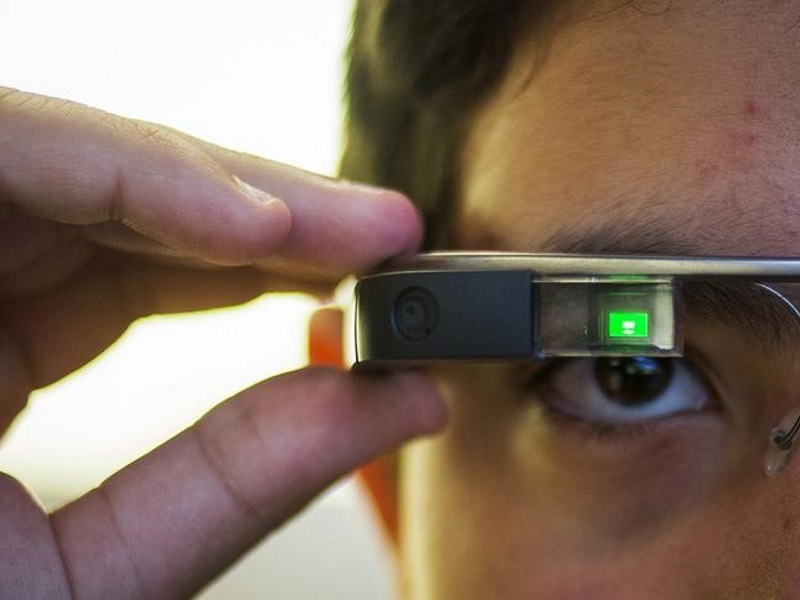
Augmedix, a startup that uses Alphabet's Google Glass to provide
documentation services to doctors and other healthcare workers, said on
Monday it had closed a $17 million (roughly Rs. 113 crores) funding round
led by investment firm Redmile Group.
Augmedix's employees transcribe doctors' notes and update patients' electronic medical record through Google Glass.
The San Francisco company, which has raised $40 million (roughly Rs. 266 crores) so far, also said it had received investments from five US healthcare networks, including Sutter Health and Dignity Health, which together have more than 100,000 healthcare workers.
Augmedix, with 400 employees, said it serves doctors in nearly all 50 US states.
Funds raised will be used to build up the service to serve more health systems and private clinics, the company said.
Augmedix is one of 10 partners authorized by Alphabet to deliver enterprise services through Google Glass.
The next generation of Google Glass wearables from the Mountain View giant has been expected for a while.
Last month, a "reliable" seller on eBay was selling what was claimed to be the Google Glass 2.0 headset, also rumoured to be called Google Glass Enterprise Edition. The listing on the shopping portal also unveiled the design changes the forthcoming model of the virtual reality glasses will sport, matching leaked images spotted in a December FCC filing.
The new Glass seems to have a folding hinge, and an outward-facing LED light. Folding hinge feature is in line with a report from last year which claimed that Google was working on the second-generation of its virtual reality headset.
According to an earlier report, Google is working on three next-generation head-mounted devices. One of them, interestingly, doesn't have a screen at all, as per the report. It's an audio-focused model meant for the sports crowd. Google is expected to unveil the Google Glass 2.0 at its upcoming developer conference I/O 2016.
Augmedix's employees transcribe doctors' notes and update patients' electronic medical record through Google Glass.
The San Francisco company, which has raised $40 million (roughly Rs. 266 crores) so far, also said it had received investments from five US healthcare networks, including Sutter Health and Dignity Health, which together have more than 100,000 healthcare workers.
Augmedix, with 400 employees, said it serves doctors in nearly all 50 US states.
Funds raised will be used to build up the service to serve more health systems and private clinics, the company said.
Augmedix is one of 10 partners authorized by Alphabet to deliver enterprise services through Google Glass.
The next generation of Google Glass wearables from the Mountain View giant has been expected for a while.
Last month, a "reliable" seller on eBay was selling what was claimed to be the Google Glass 2.0 headset, also rumoured to be called Google Glass Enterprise Edition. The listing on the shopping portal also unveiled the design changes the forthcoming model of the virtual reality glasses will sport, matching leaked images spotted in a December FCC filing.
The new Glass seems to have a folding hinge, and an outward-facing LED light. Folding hinge feature is in line with a report from last year which claimed that Google was working on the second-generation of its virtual reality headset.
According to an earlier report, Google is working on three next-generation head-mounted devices. One of them, interestingly, doesn't have a screen at all, as per the report. It's an audio-focused model meant for the sports crowd. Google is expected to unveil the Google Glass 2.0 at its upcoming developer conference I/O 2016.
Bitcoin Genesis: Wright Says Sorry, Won't Provide Fresh Proof He Created Bitcoin

Australian Craig Wright on Thursday went back on a promise to provide
further proof that he created Bitcoin because he was "not strong
enough" for the public scrutiny, raising fresh doubts over his claim.
The secretive businessman on Monday identified himself as the creator of the pioneering digital currency after years of speculation about who invented it.
The move stunned the world of virtual currencies, although some experts were not convinced, and Wright promised to provide further "extraordinary proof".
Bitcoin is a technically sophisticated currency based on the same underlying mathematics as governments and militaries use to encrypt codes.
Unlike traditional currencies such as the dollar or the euro, which require the sponsorship of a central bank, Bitcoin is decentralised.
"I believed that I could do this. I believed that I could put the years of anonymity and hiding behind me," read a statement posted on his website.
"But, as the events of this week unfolded and I prepared to publish the proof of access to the earliest keys, I broke. I do not have the courage."
The Outside Organisation, a public relations firm that has worked with Wright, said the statement was "legitimate" but declined to comment further.
Wright had made his claim through three media outlets - the BBC, The Economist and GQ magazine - and also wrote a blog.
The BBC said Wright had presented some proof that only the true creator of Bitcoin could have provided.
It posted a video of him demonstrating the signing of a message with the public key associated with the first transaction ever done on Bitcoin following its 2009 launch.
These keys had to be created by Satoshi Nakamoto, the pseudonym used at the time by the currency's creator, the British broadcaster said.
But The Economist was more sceptical, saying there were still a number of steps to go through in order to verify the claim and "important questions remain".
Digital coins are created by supercomputers and then traded online or exchanged for goods and services by a peer-to-peer network of computers connected to the Internet.
Despite some early notoriety over its use by drug dealers on the dark web, the system has grown beyond its radical libertarian roots and is being taken increasingly seriously by the financial establishment.
Billions of dollars worth of Bitcoins are now in circulation.
'I'm Sorry... And goodbye'The BBC's technology correspondent, Rory Cellan-Jones, said Wright's refusal to provide more proof was "bound to raise fresh doubts" about his claim.
Cellan-Jones said that Wright in the last 24 hours had "initiated an experiment designed to show that he does possess Satoshi's cryptographic keys, then done an about-turn".
"I have always stressed that it was his endorsement by Jon Matonis and Gavin Andresen from the Bitcoin Foundation that we found compelling," the journalist wrote.
"But now they - and I - have been involved in this failed experiment, which is bound to raise fresh doubts."
In his statement on Thursday, Wright mentioned both Matonis and Andresen, saying he hoped their credibility would not be "irreparably tainted".
"They were not deceived, but I know that the world will never believe that now," he said.
Wright said his "qualifications and character were attacked" and he was "not strong enough".
"I know that this weakness will cause great damage to those that have supported me," he said.
"I'm Sorry" read the title of Wright's statement, which ended with the words: "And goodbye"
The secretive businessman on Monday identified himself as the creator of the pioneering digital currency after years of speculation about who invented it.
The move stunned the world of virtual currencies, although some experts were not convinced, and Wright promised to provide further "extraordinary proof".
Bitcoin is a technically sophisticated currency based on the same underlying mathematics as governments and militaries use to encrypt codes.
Unlike traditional currencies such as the dollar or the euro, which require the sponsorship of a central bank, Bitcoin is decentralised.
"I believed that I could do this. I believed that I could put the years of anonymity and hiding behind me," read a statement posted on his website.
"But, as the events of this week unfolded and I prepared to publish the proof of access to the earliest keys, I broke. I do not have the courage."
The Outside Organisation, a public relations firm that has worked with Wright, said the statement was "legitimate" but declined to comment further.
Wright had made his claim through three media outlets - the BBC, The Economist and GQ magazine - and also wrote a blog.
The BBC said Wright had presented some proof that only the true creator of Bitcoin could have provided.
It posted a video of him demonstrating the signing of a message with the public key associated with the first transaction ever done on Bitcoin following its 2009 launch.
These keys had to be created by Satoshi Nakamoto, the pseudonym used at the time by the currency's creator, the British broadcaster said.
But The Economist was more sceptical, saying there were still a number of steps to go through in order to verify the claim and "important questions remain".
Digital coins are created by supercomputers and then traded online or exchanged for goods and services by a peer-to-peer network of computers connected to the Internet.
Despite some early notoriety over its use by drug dealers on the dark web, the system has grown beyond its radical libertarian roots and is being taken increasingly seriously by the financial establishment.
Billions of dollars worth of Bitcoins are now in circulation.
'I'm Sorry... And goodbye'The BBC's technology correspondent, Rory Cellan-Jones, said Wright's refusal to provide more proof was "bound to raise fresh doubts" about his claim.
Cellan-Jones said that Wright in the last 24 hours had "initiated an experiment designed to show that he does possess Satoshi's cryptographic keys, then done an about-turn".
"I have always stressed that it was his endorsement by Jon Matonis and Gavin Andresen from the Bitcoin Foundation that we found compelling," the journalist wrote.
"But now they - and I - have been involved in this failed experiment, which is bound to raise fresh doubts."
In his statement on Thursday, Wright mentioned both Matonis and Andresen, saying he hoped their credibility would not be "irreparably tainted".
"They were not deceived, but I know that the world will never believe that now," he said.
Wright said his "qualifications and character were attacked" and he was "not strong enough".
"I know that this weakness will cause great damage to those that have supported me," he said.
"I'm Sorry" read the title of Wright's statement, which ended with the words: "And goodbye"

